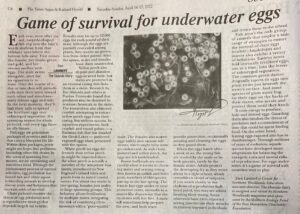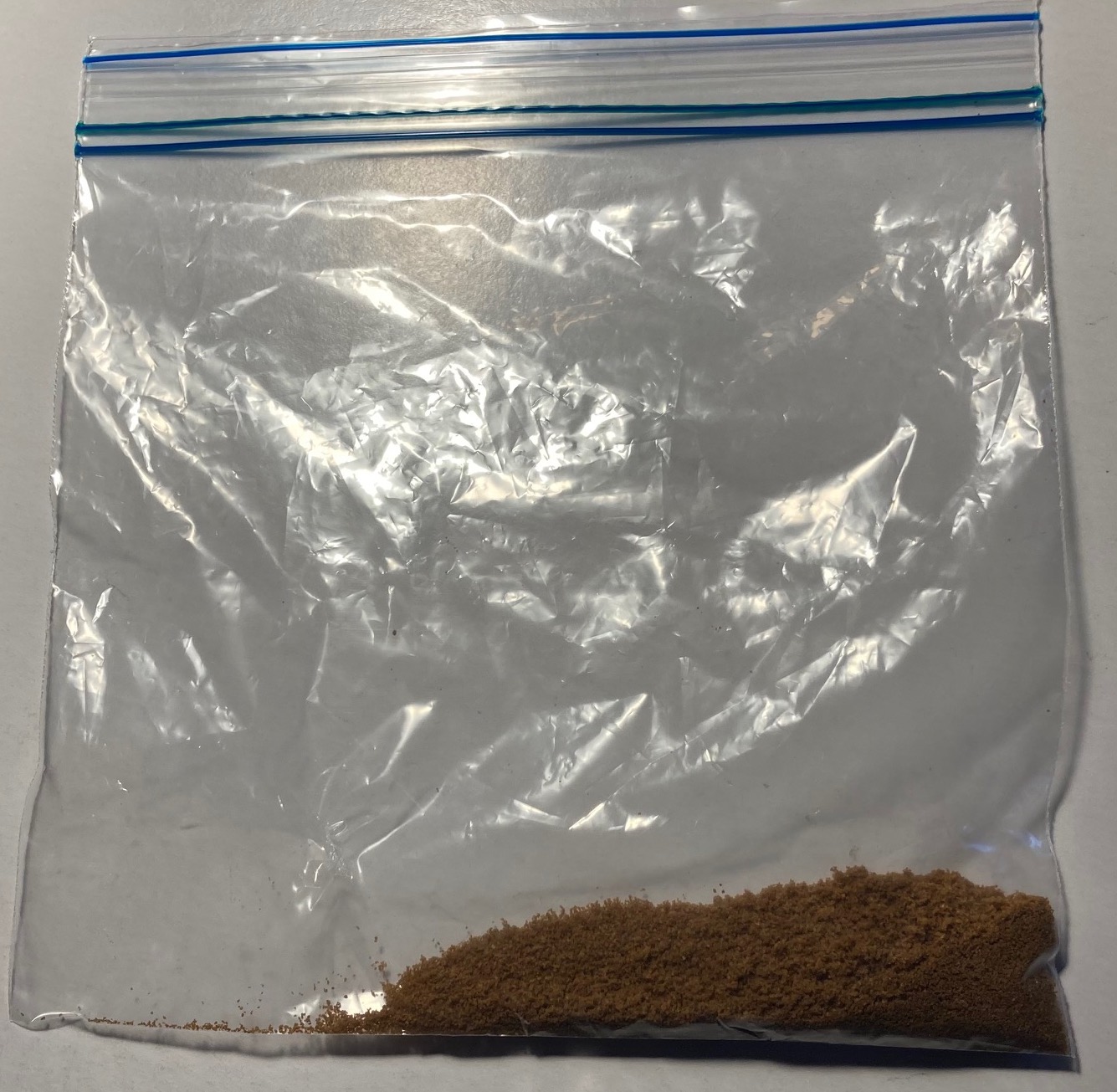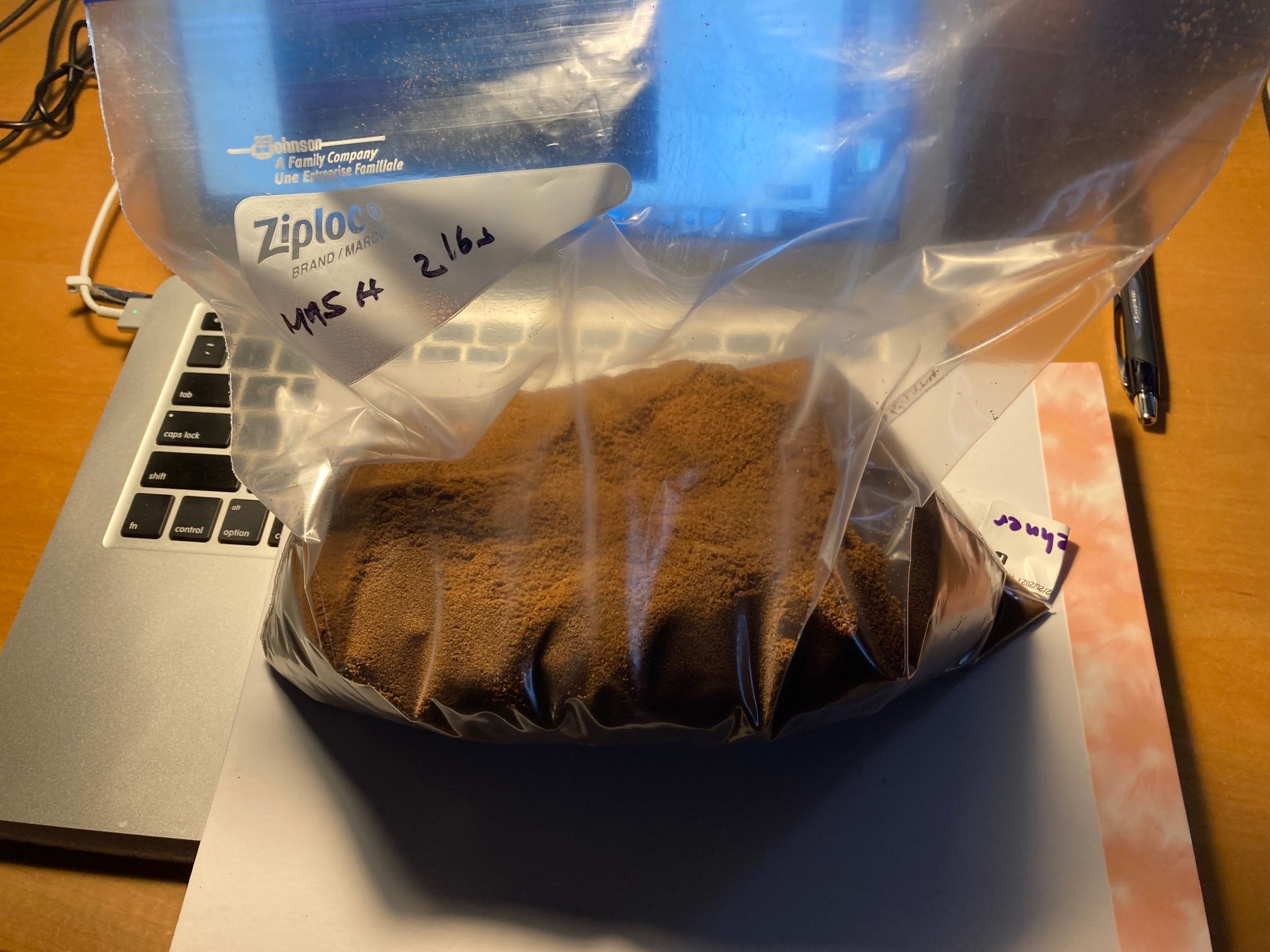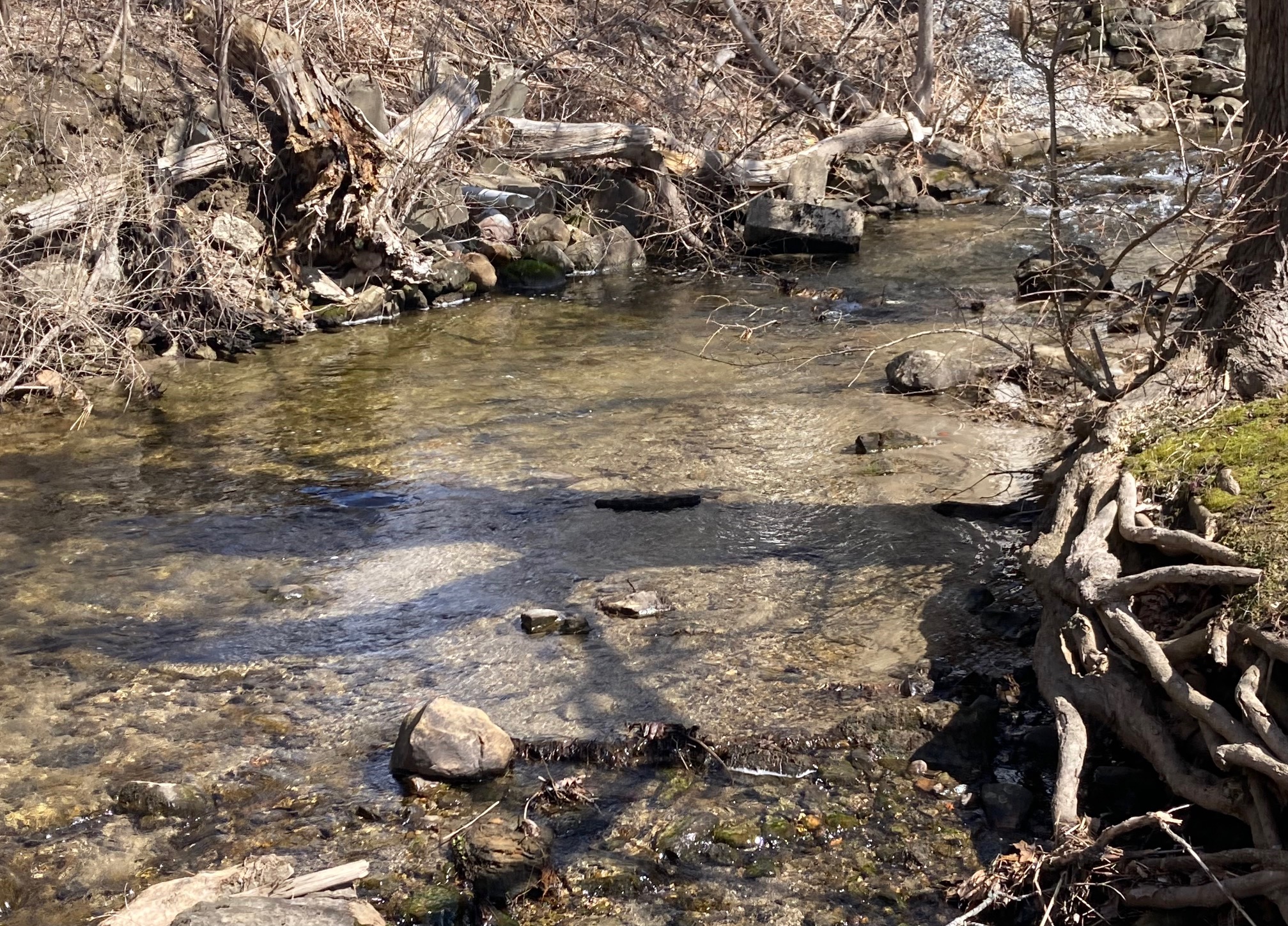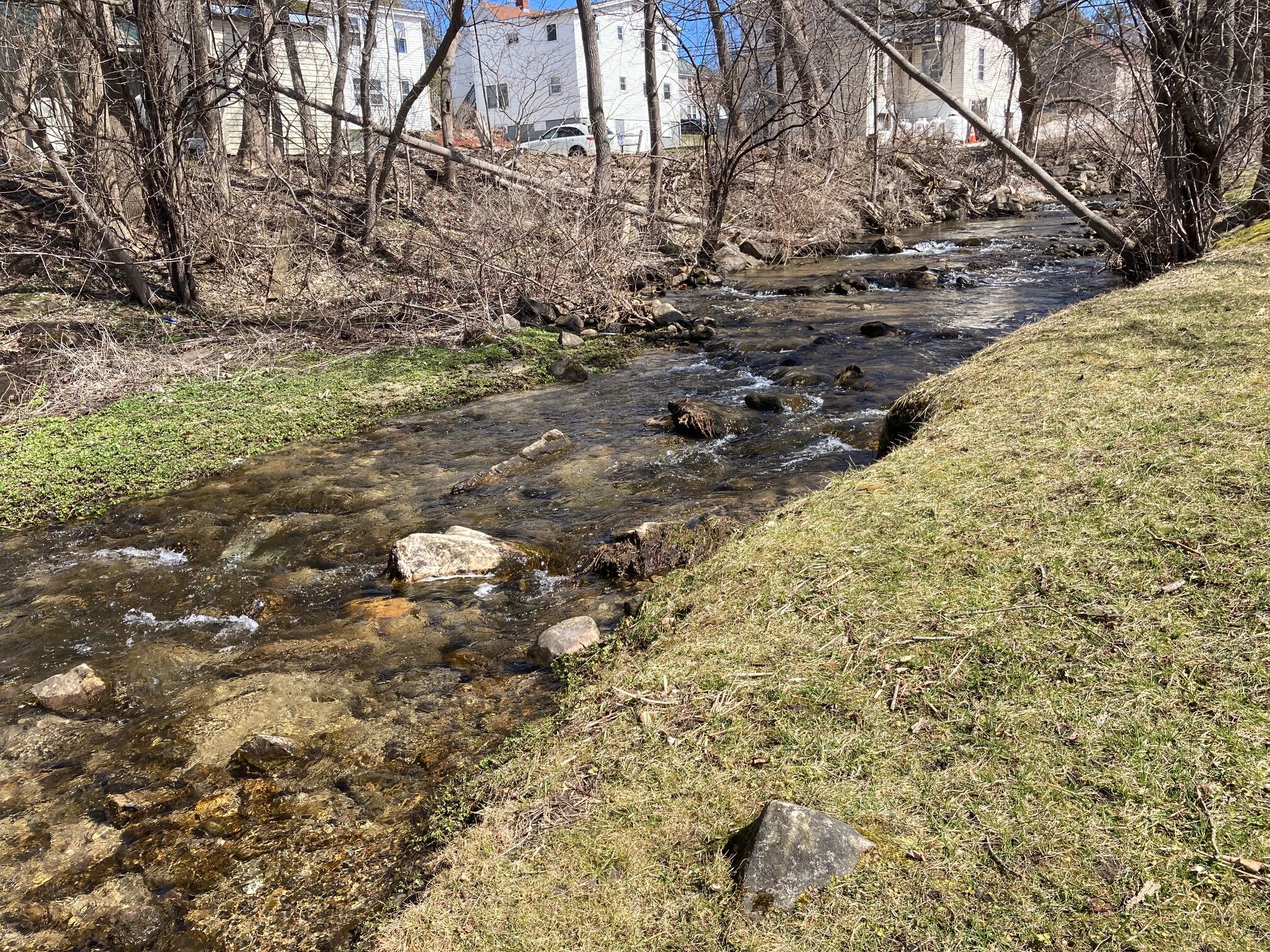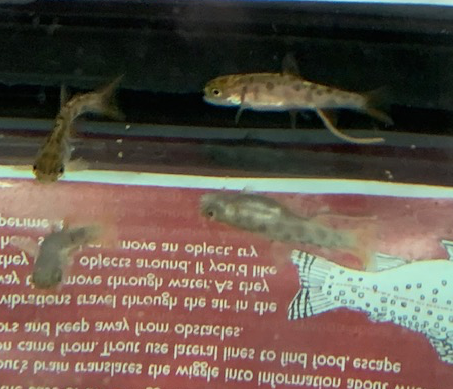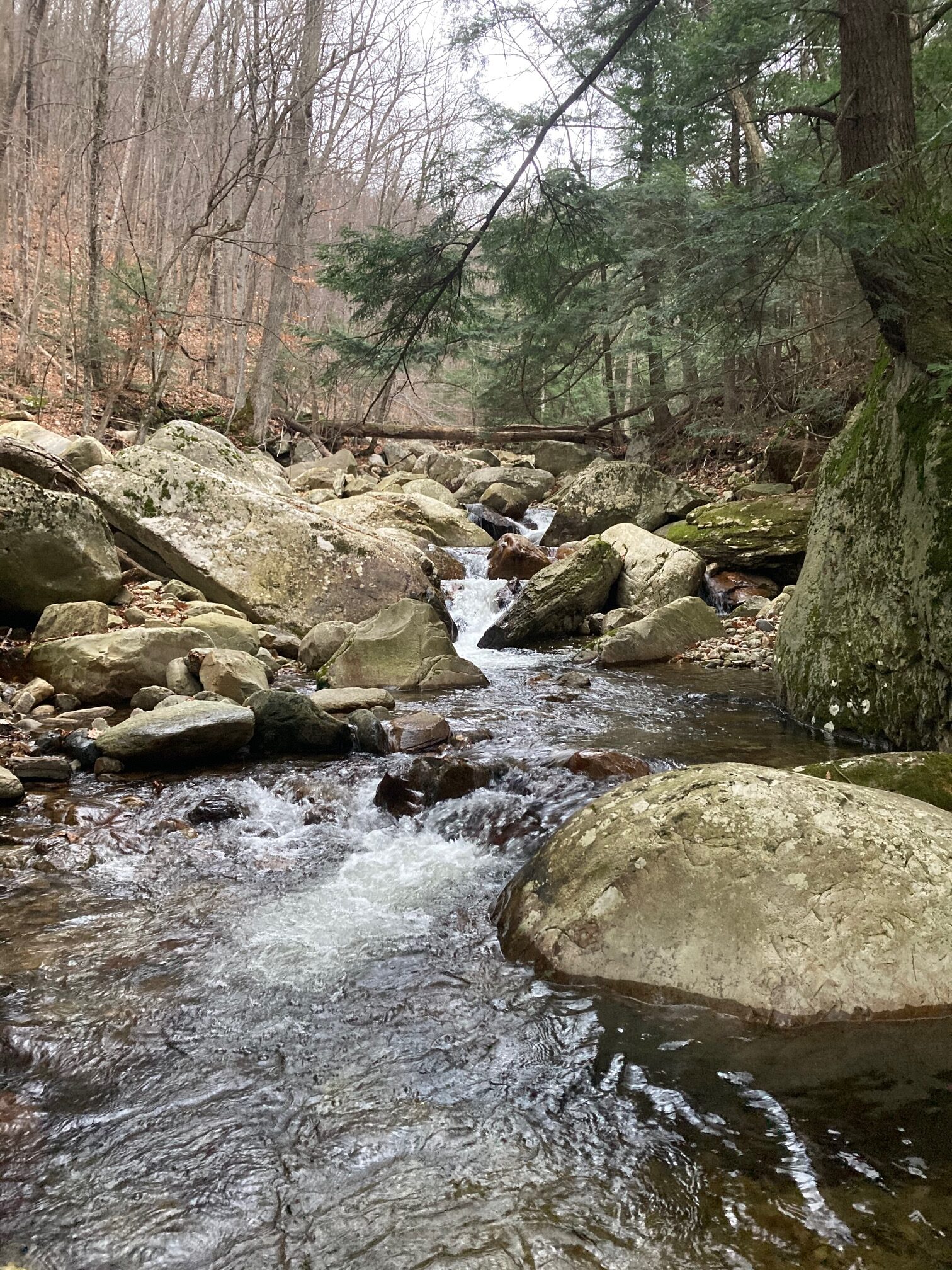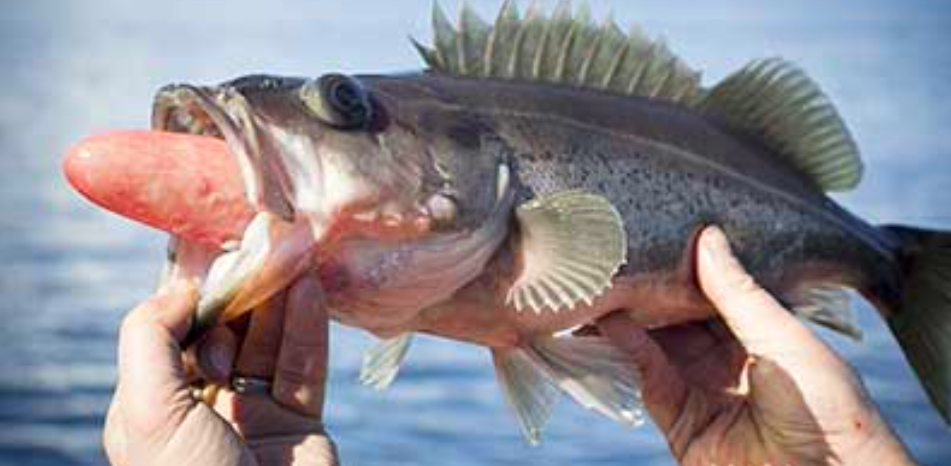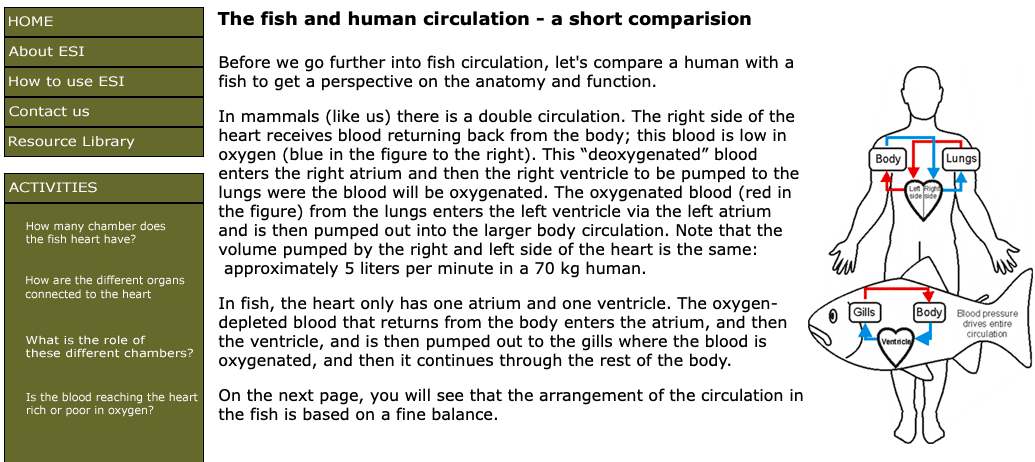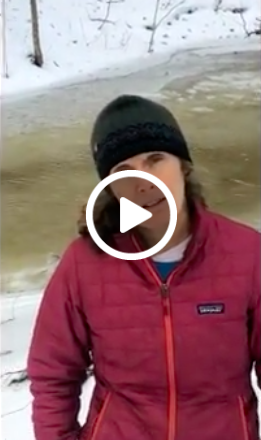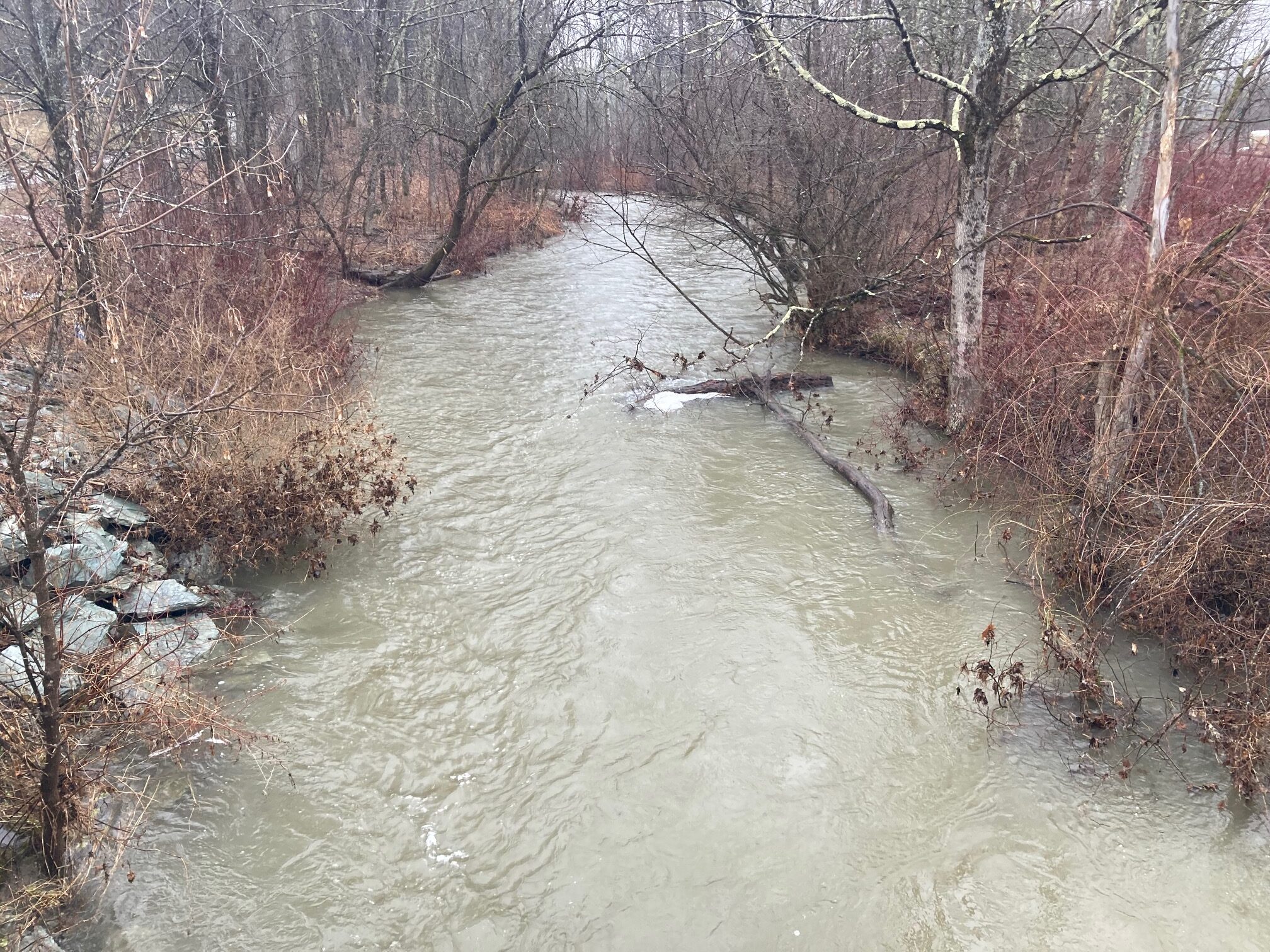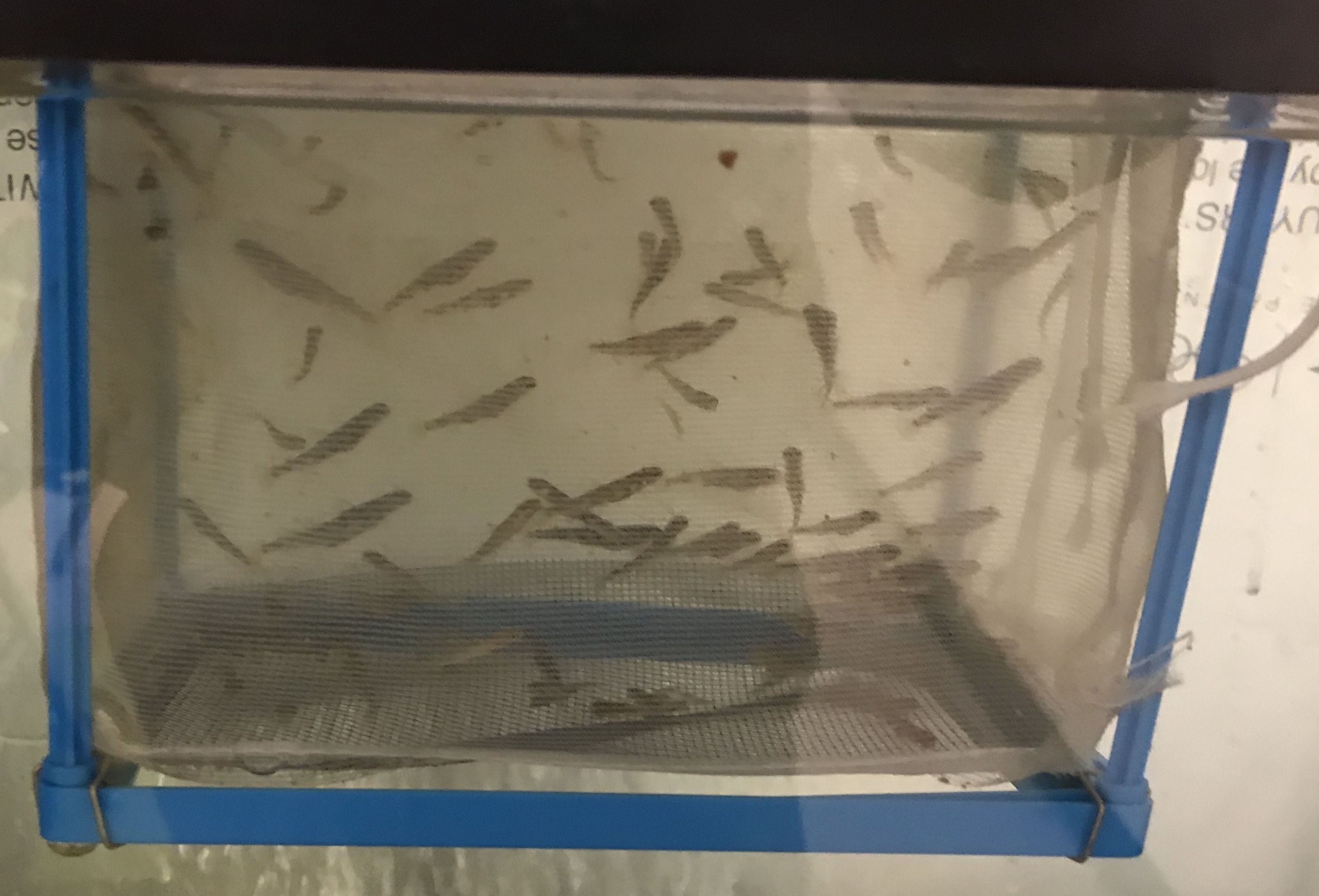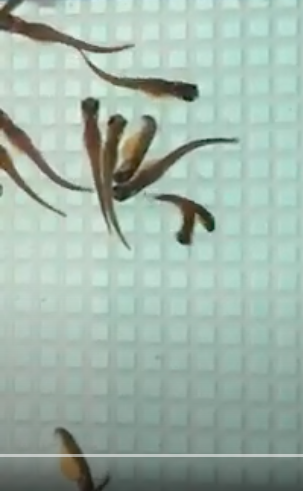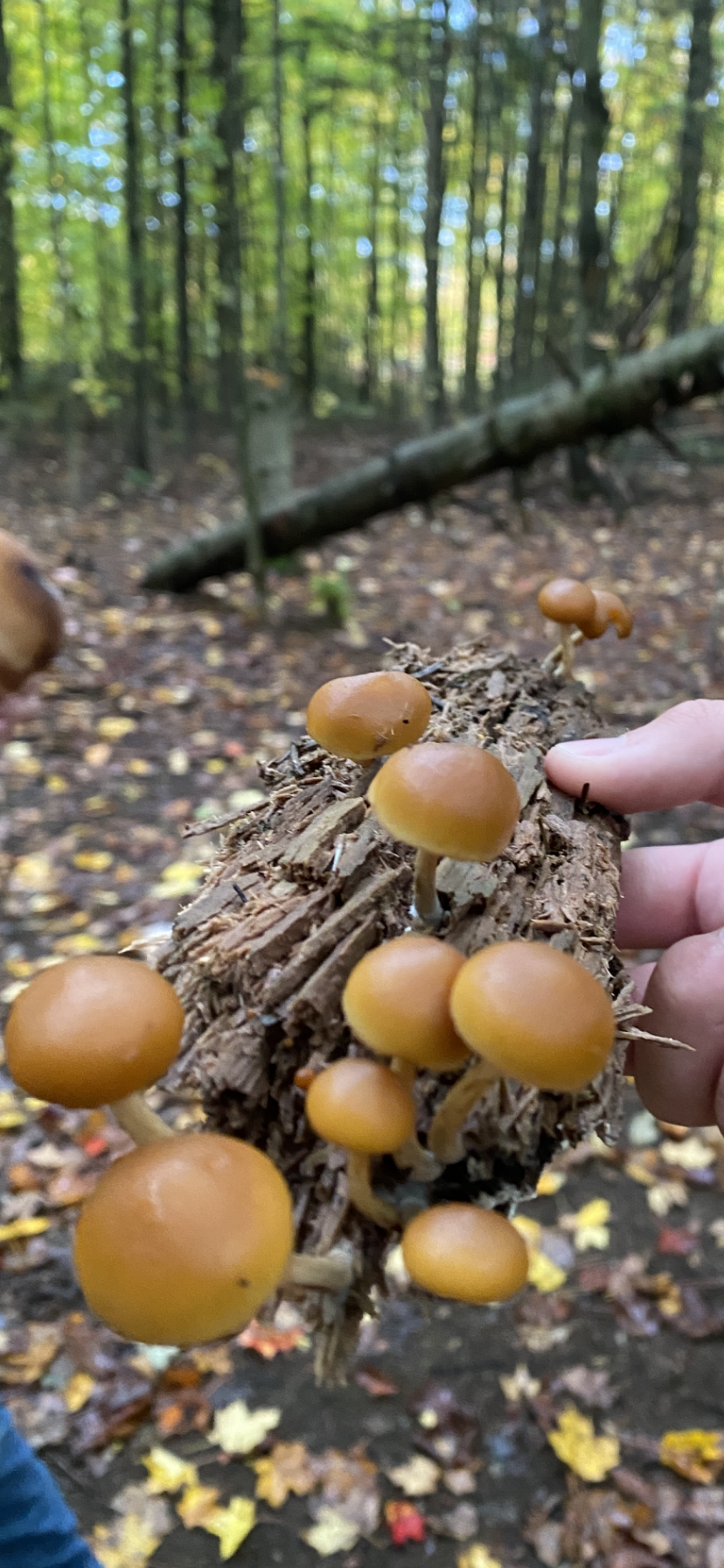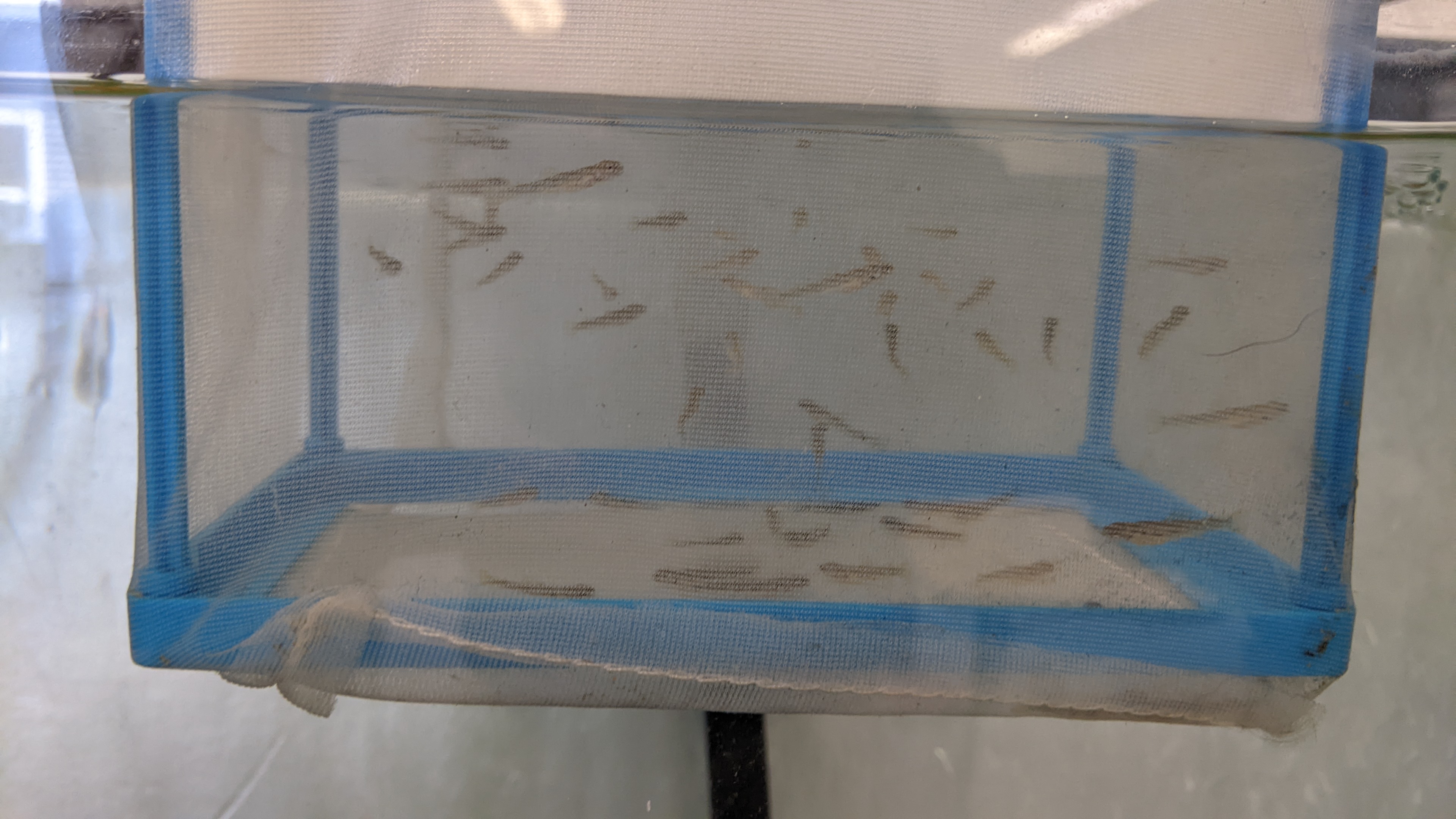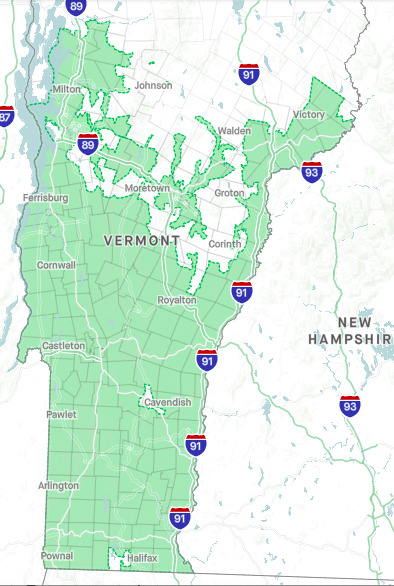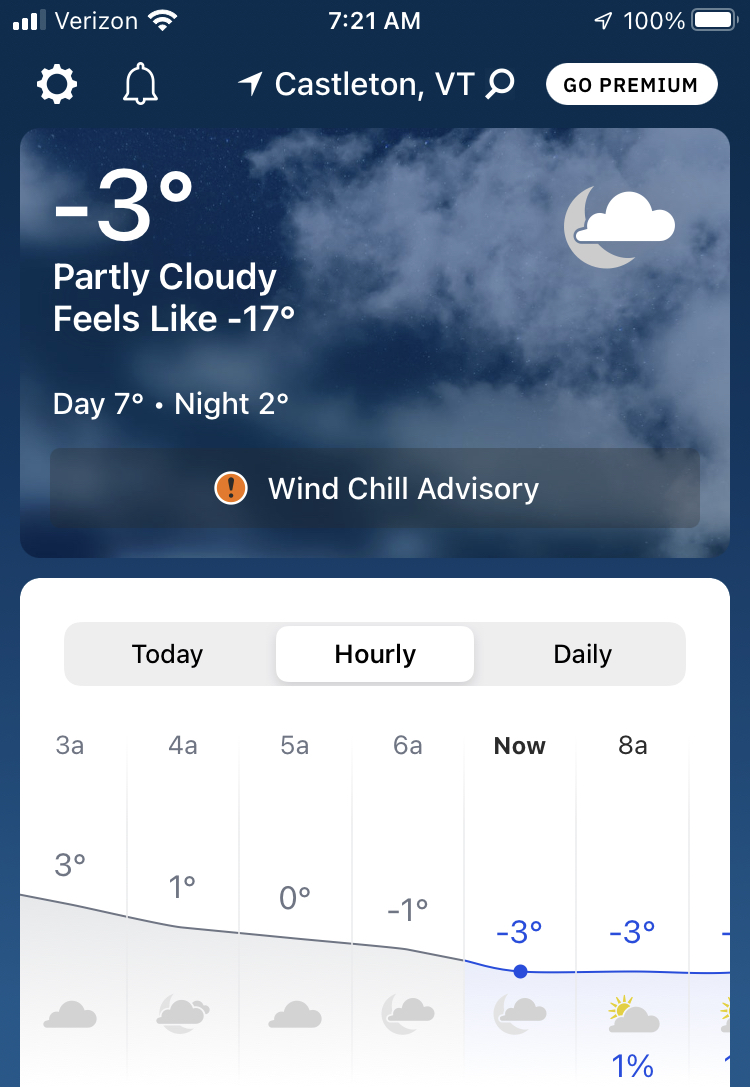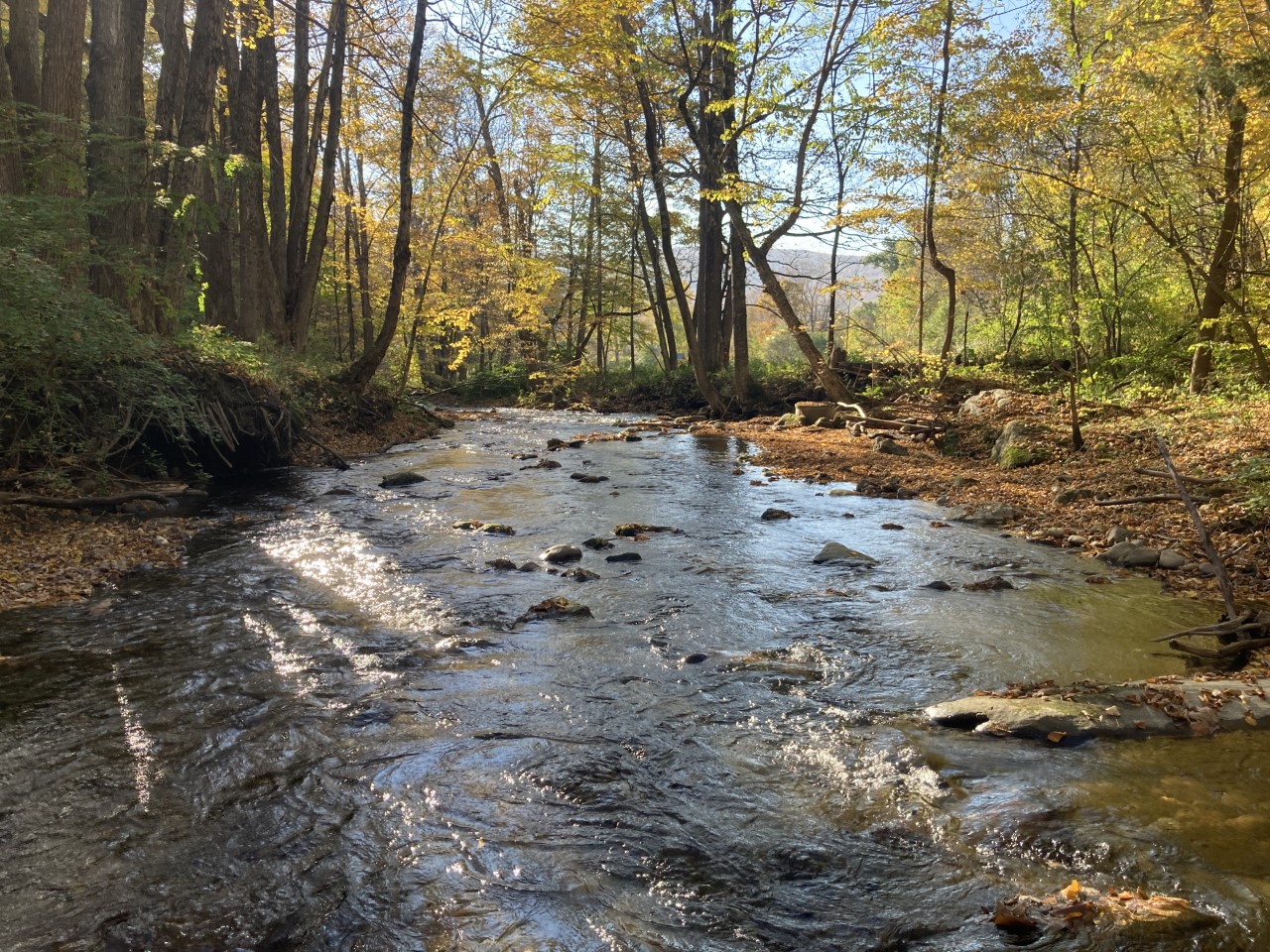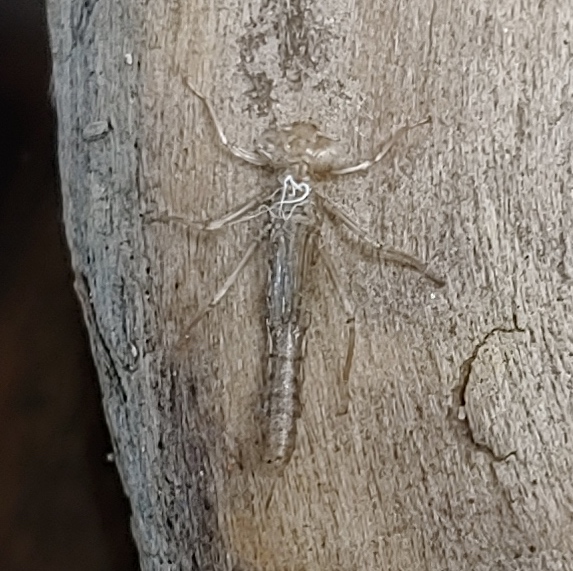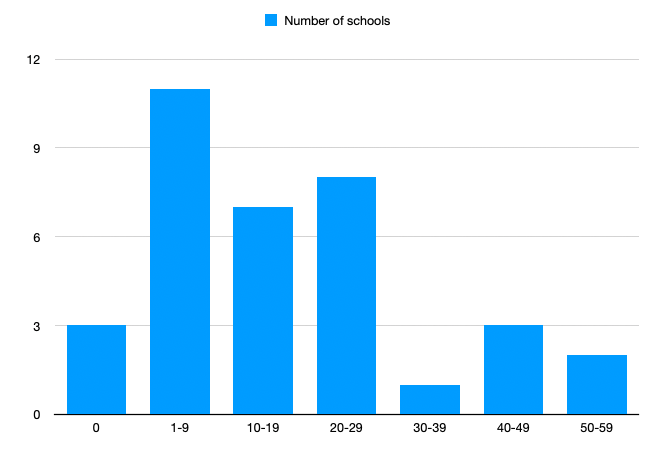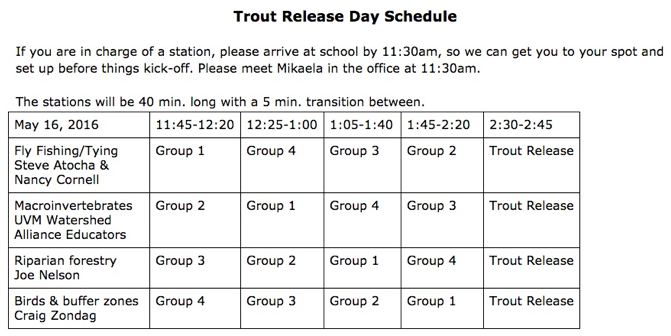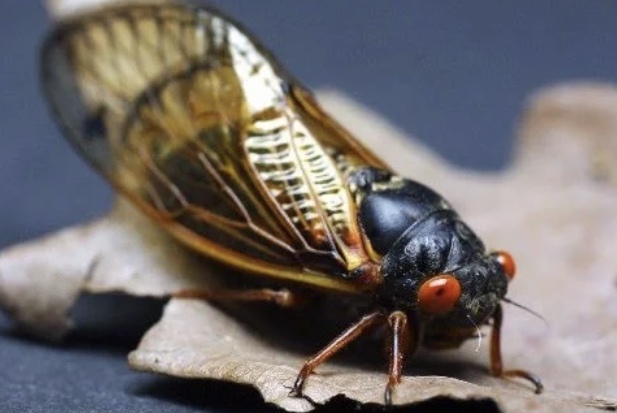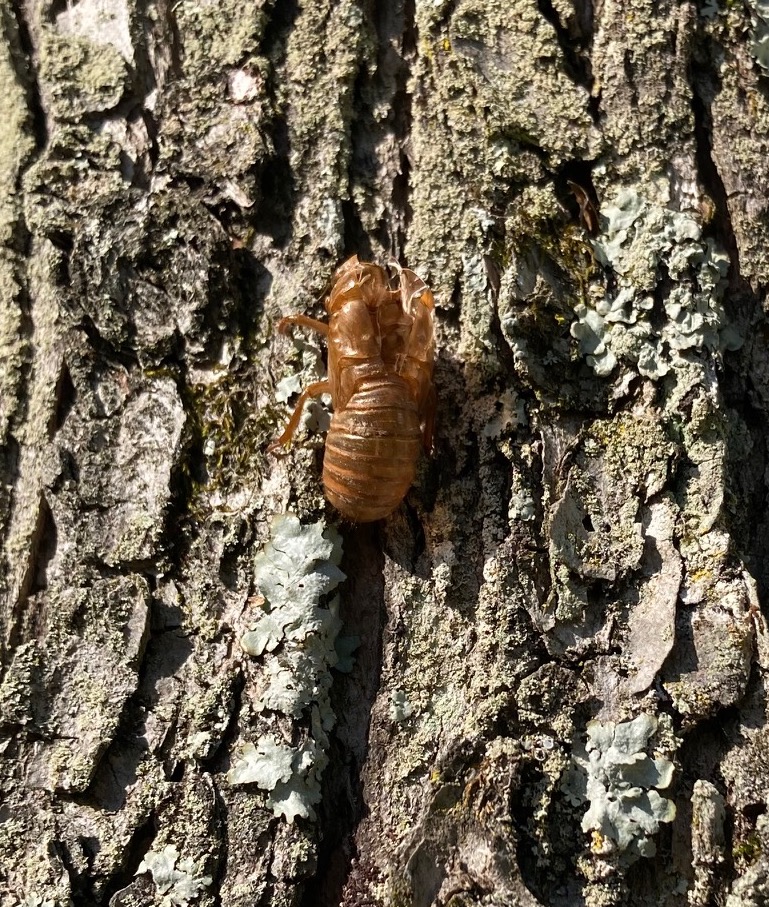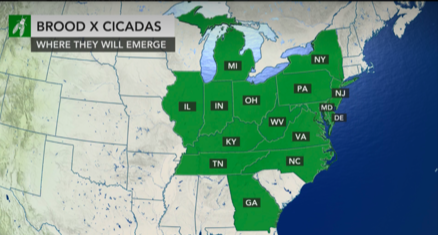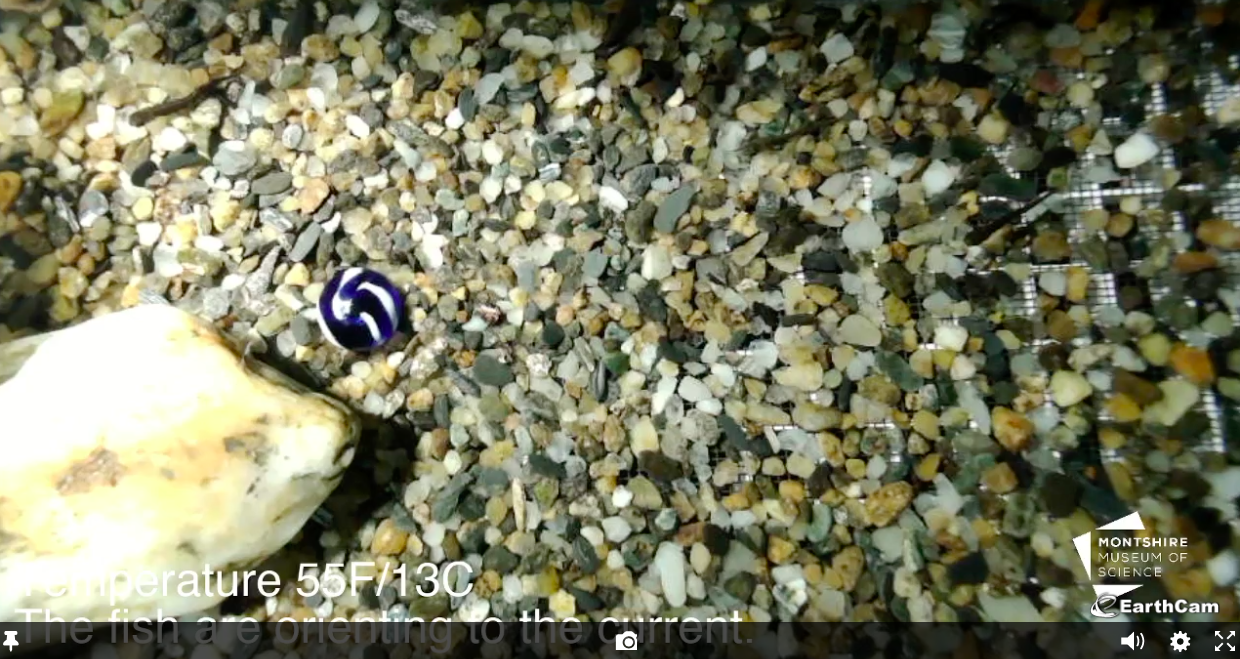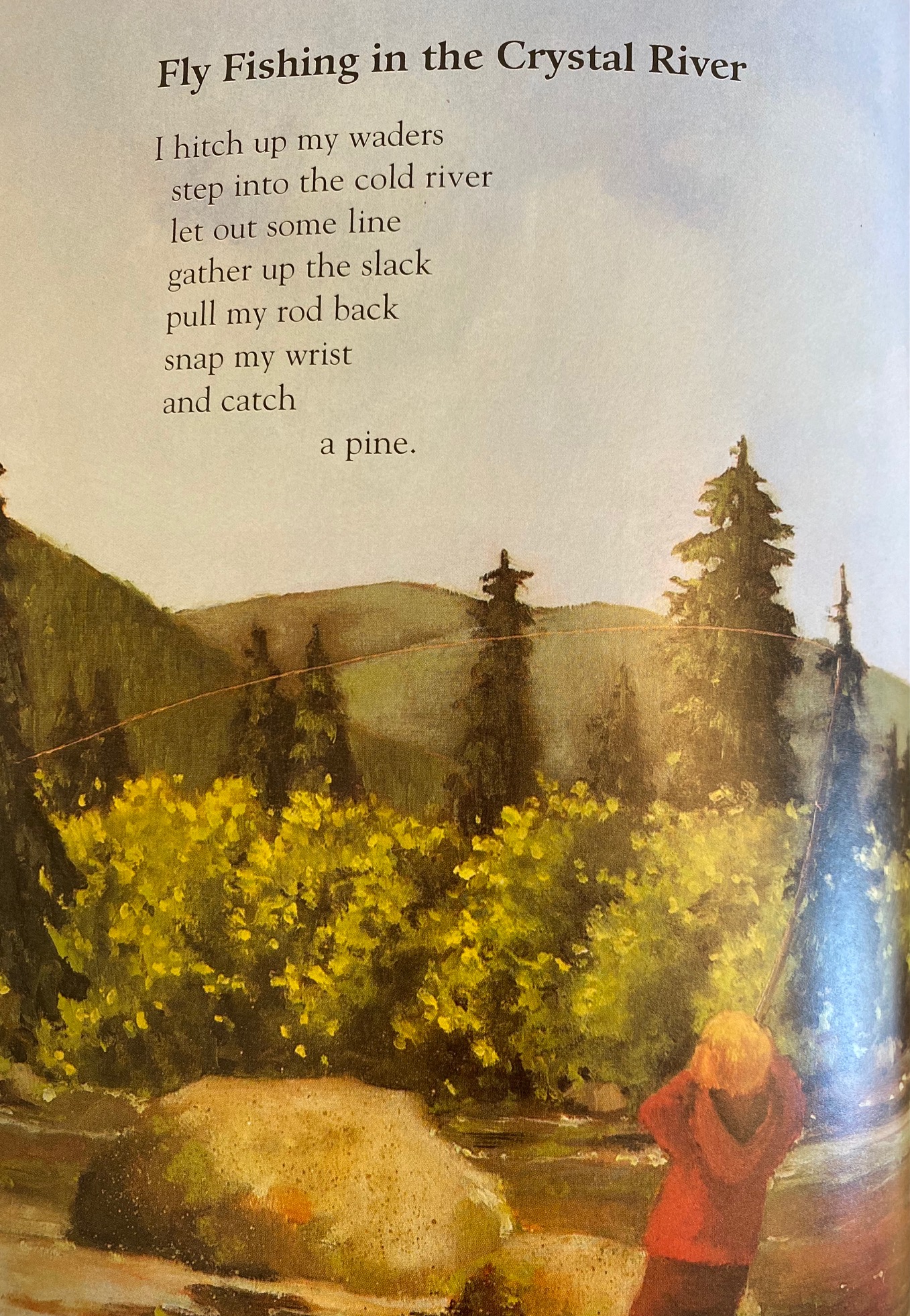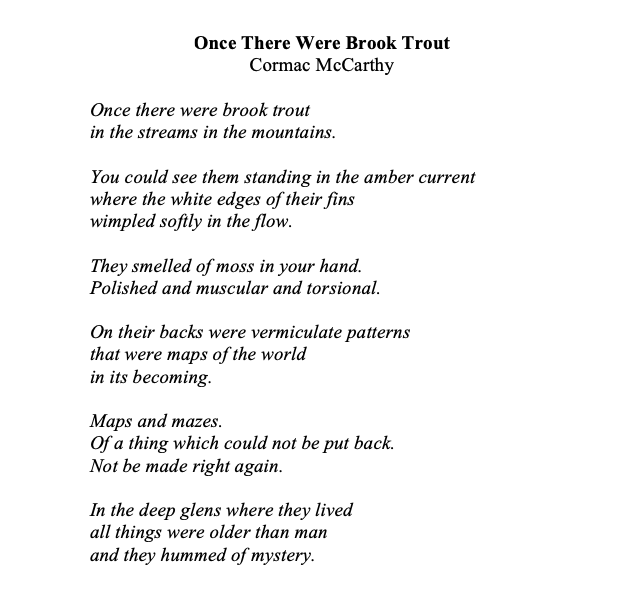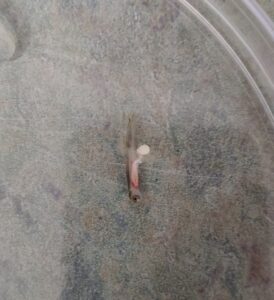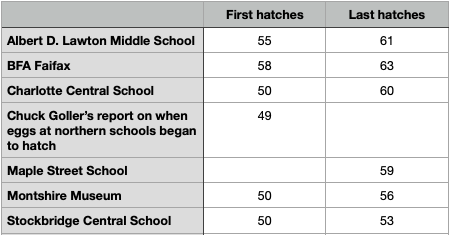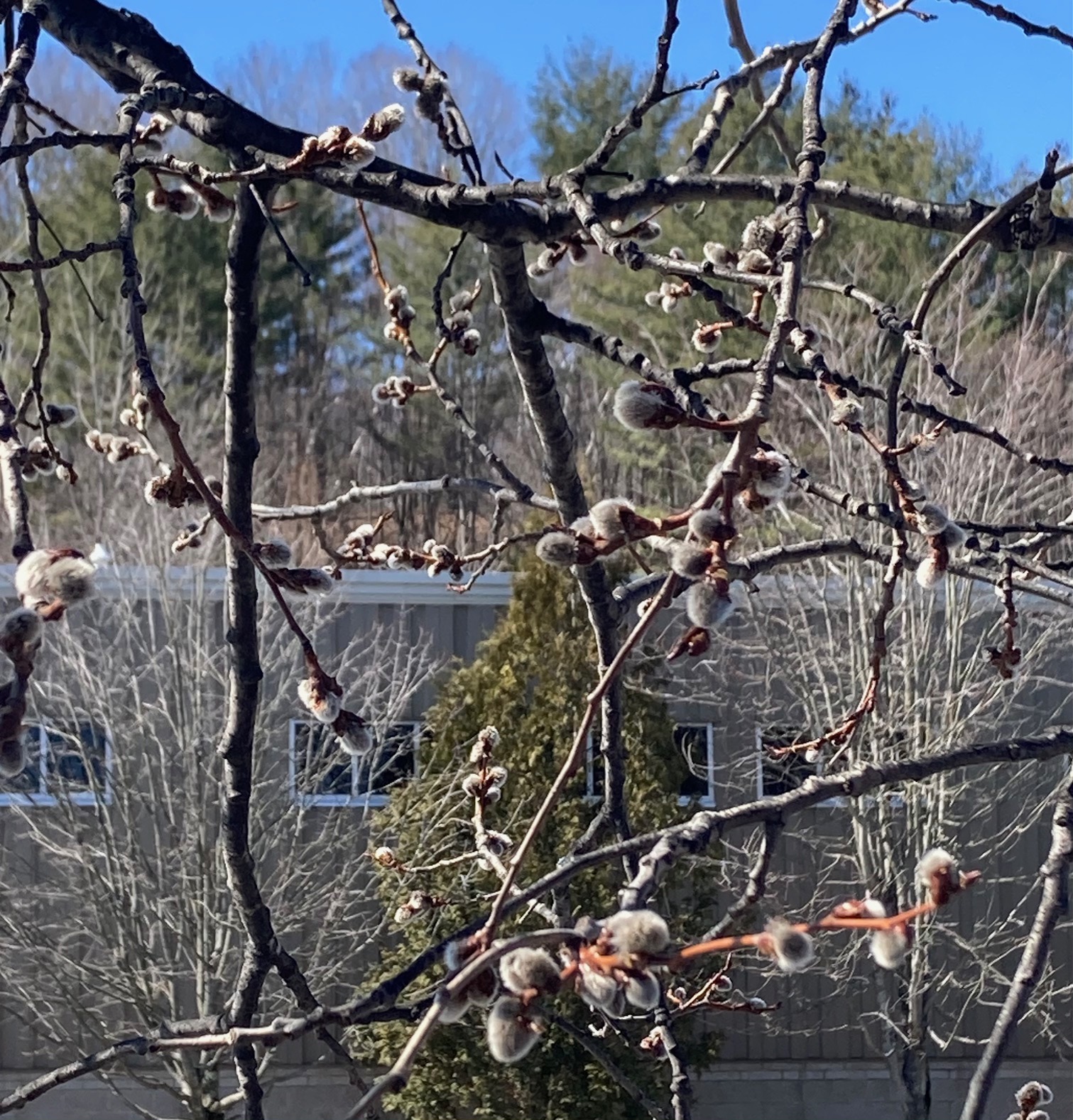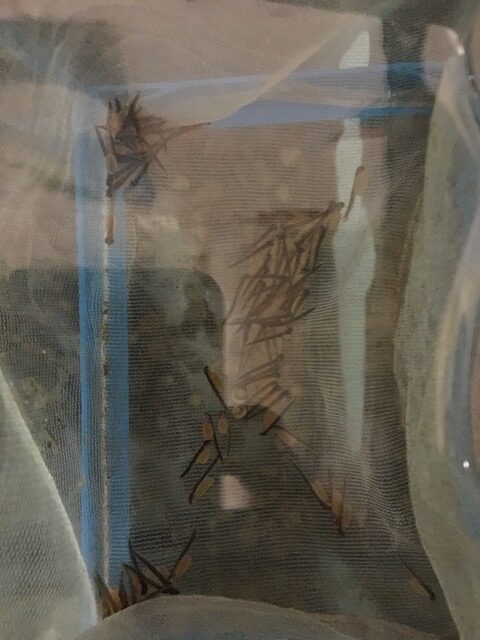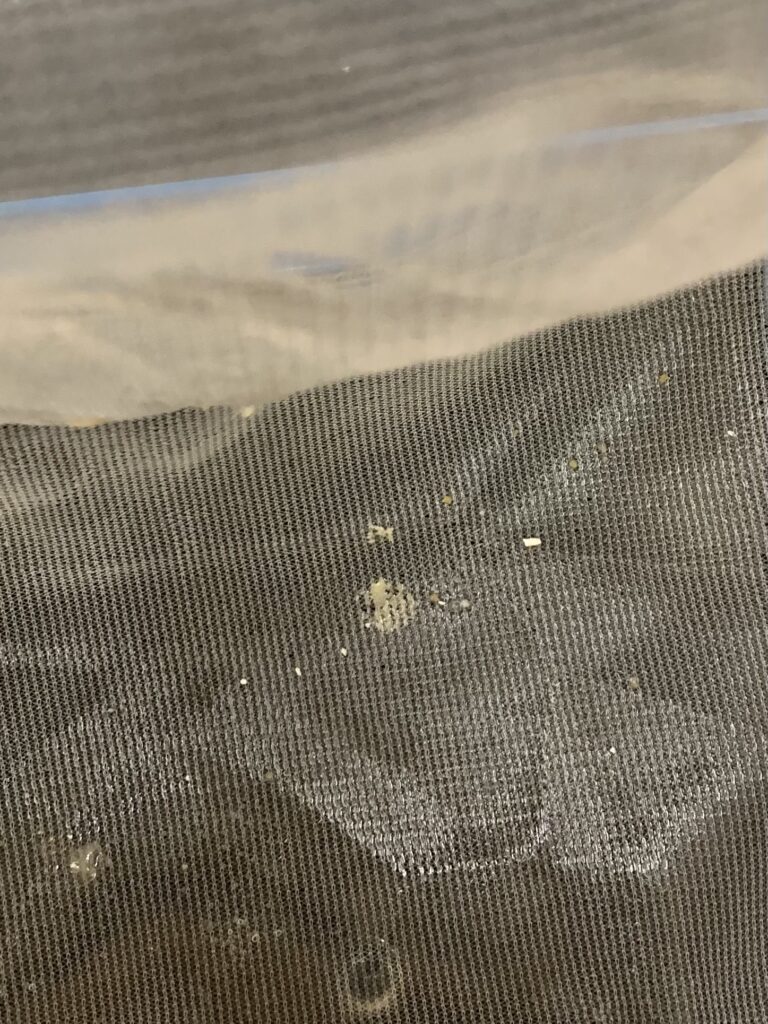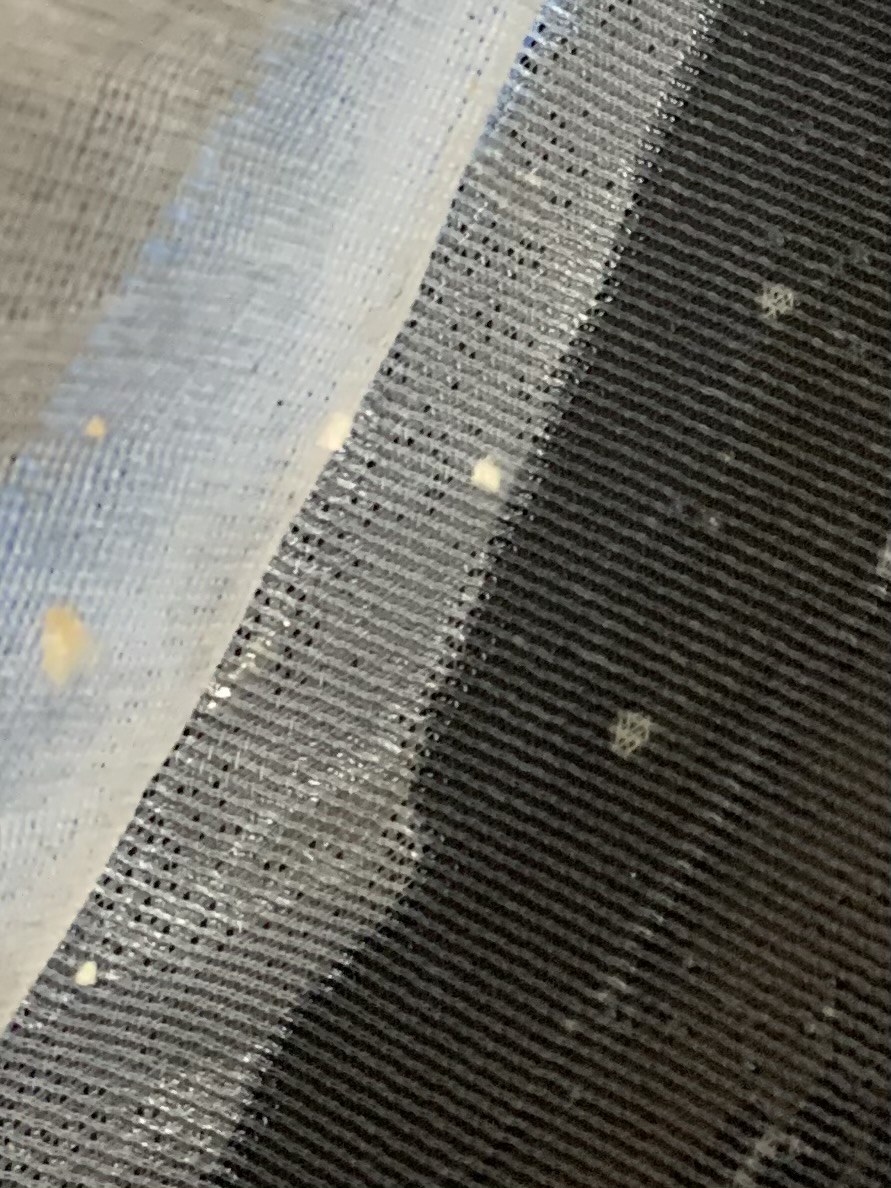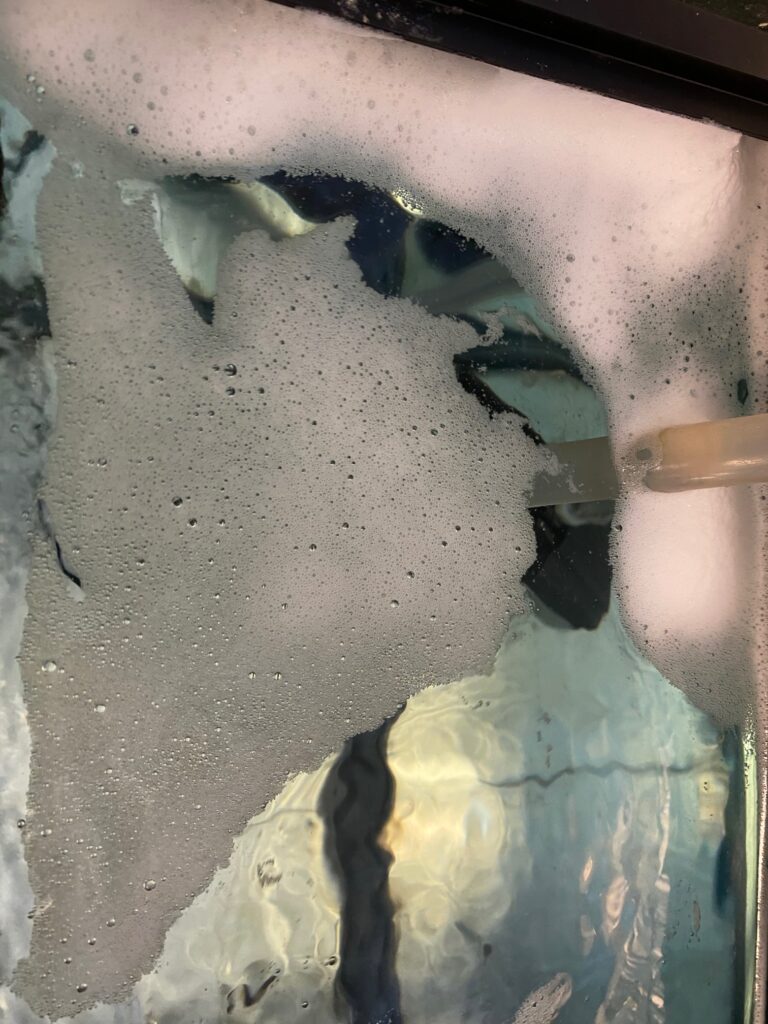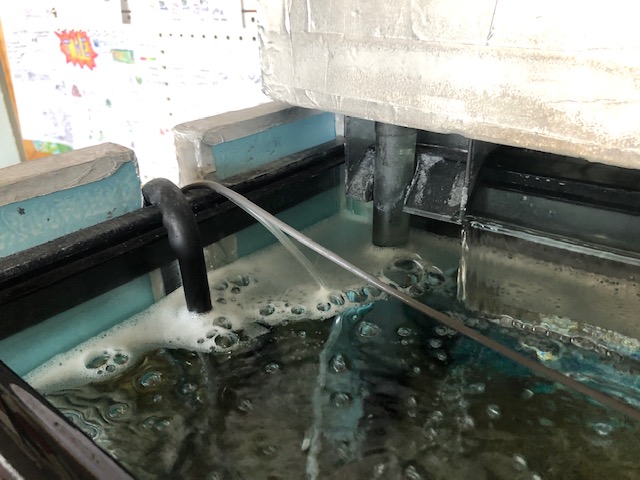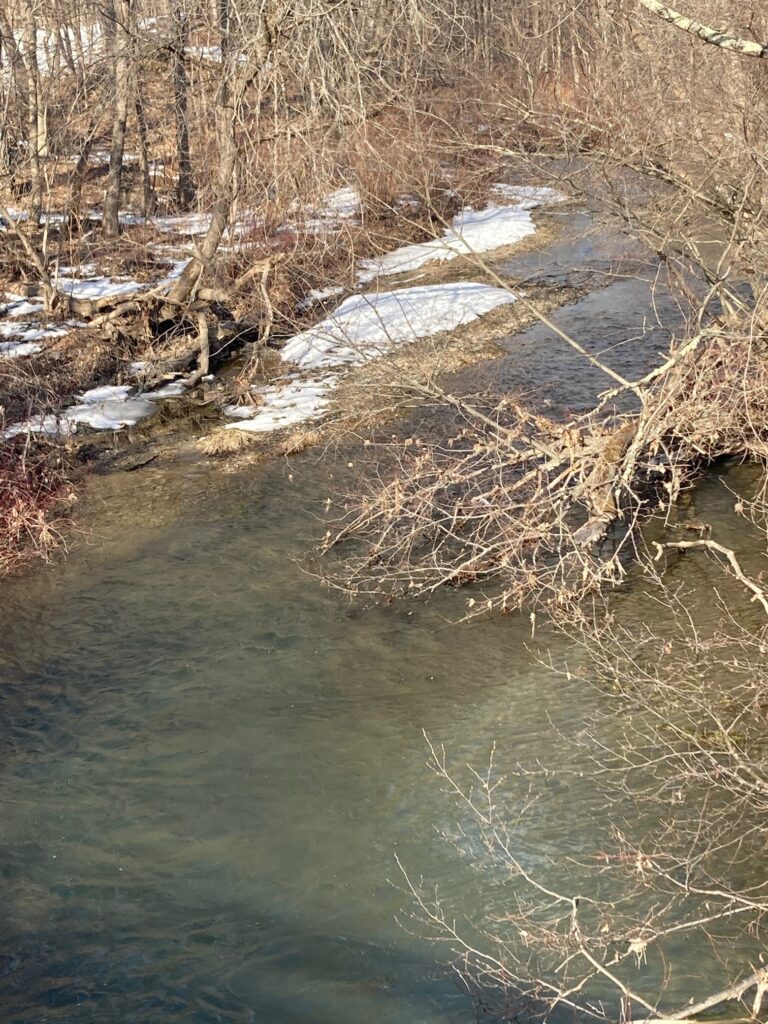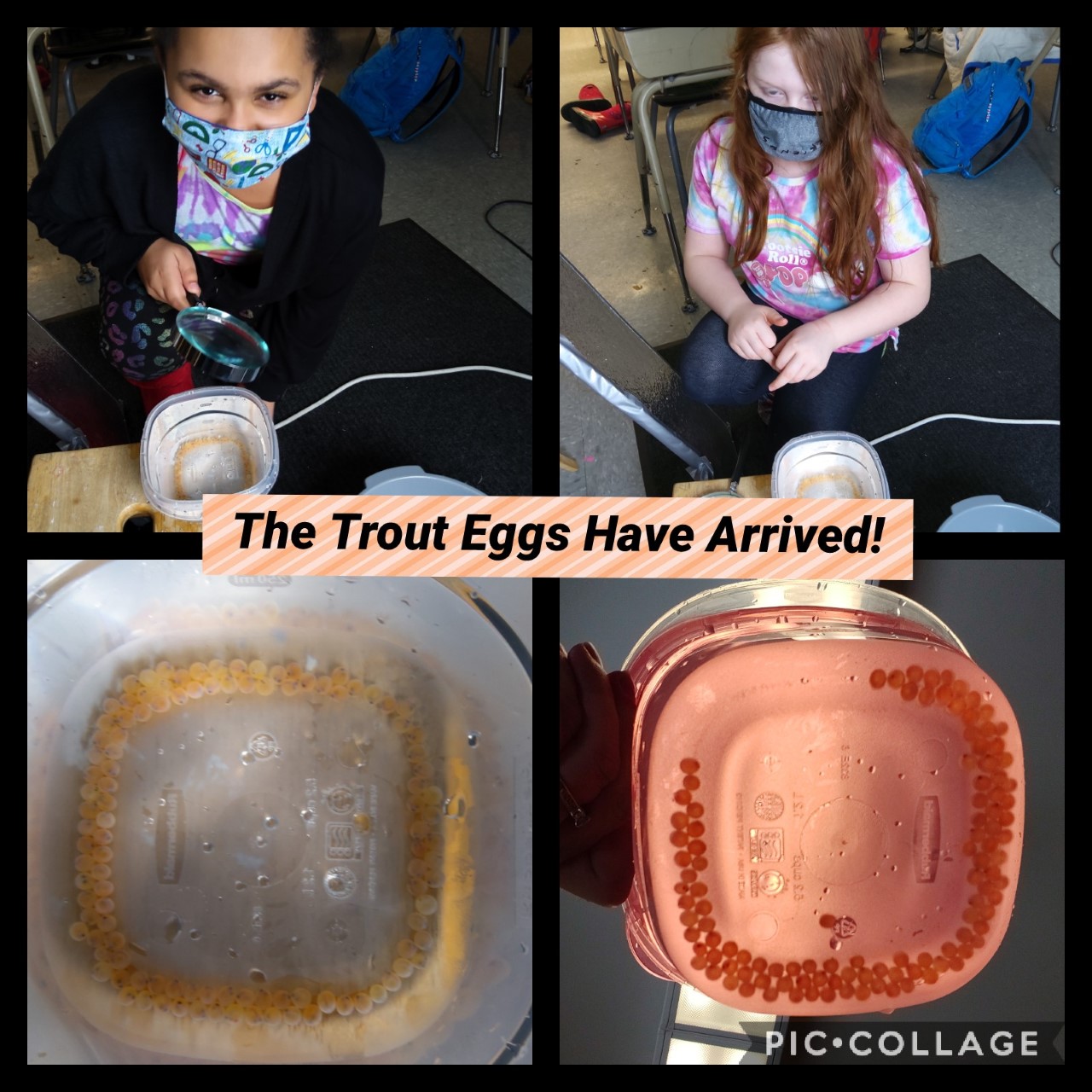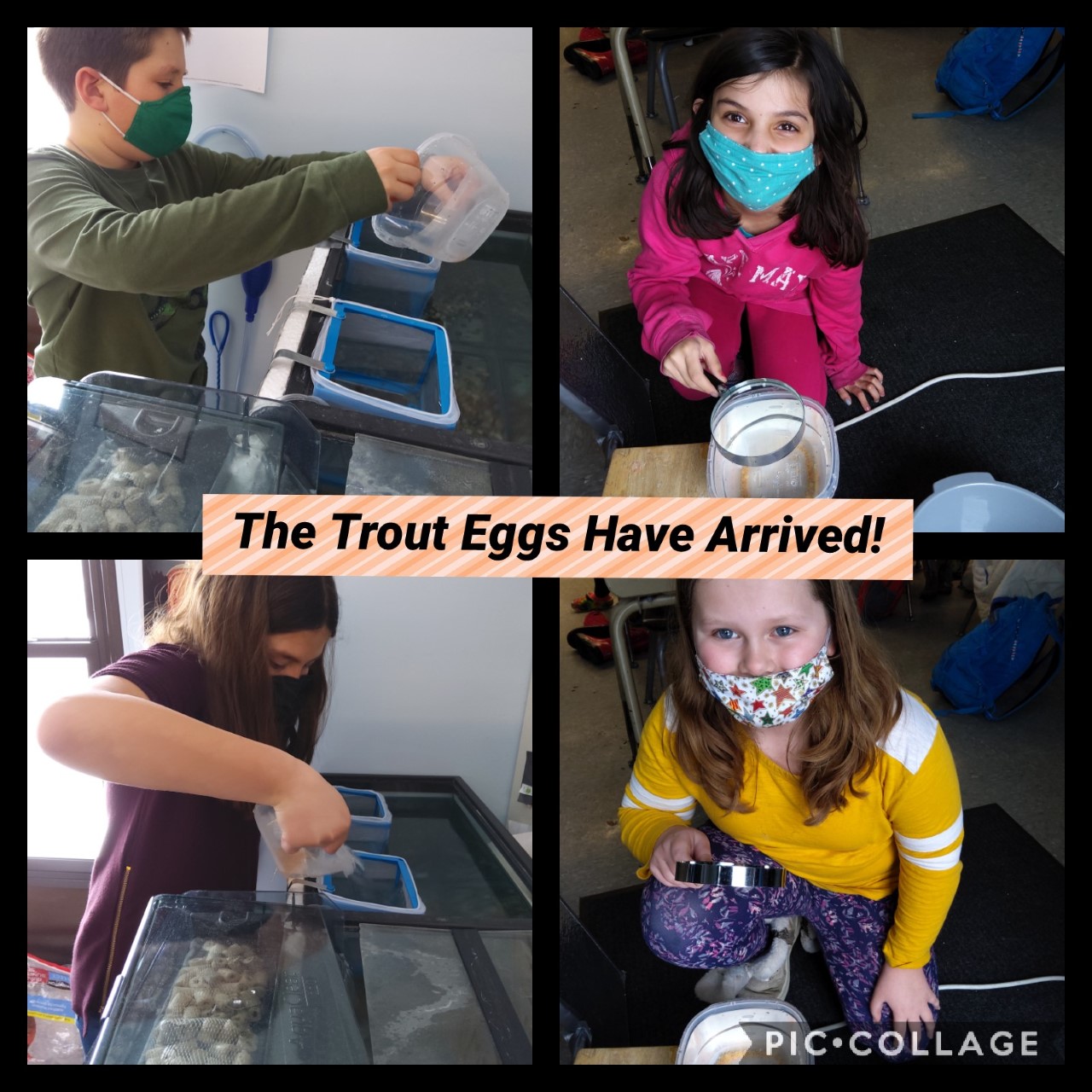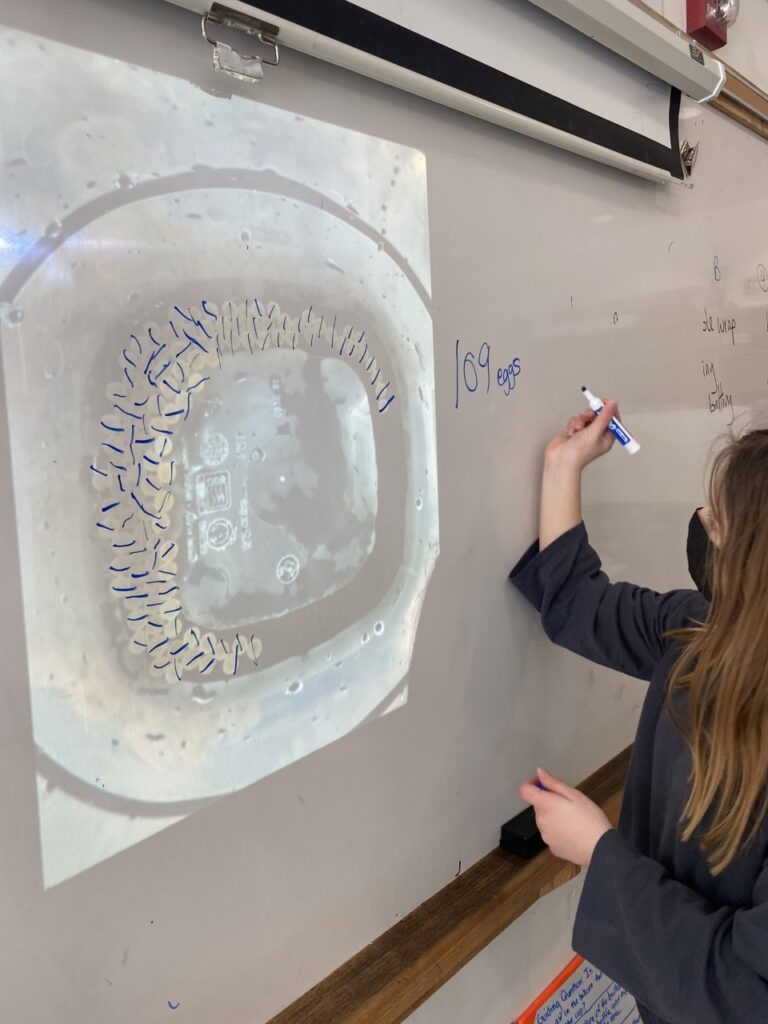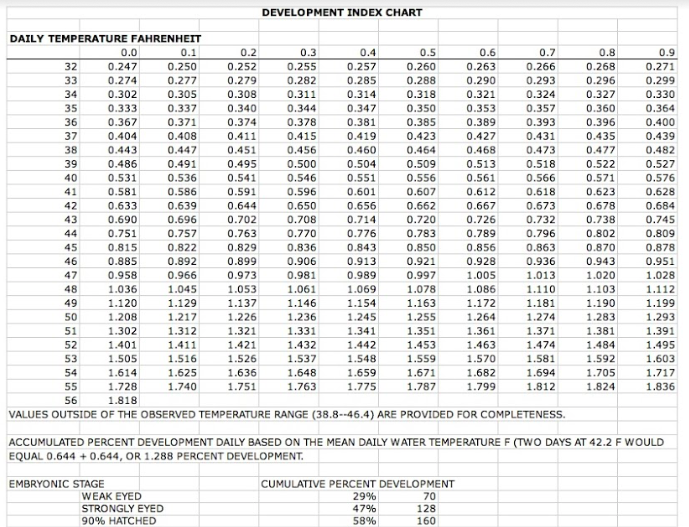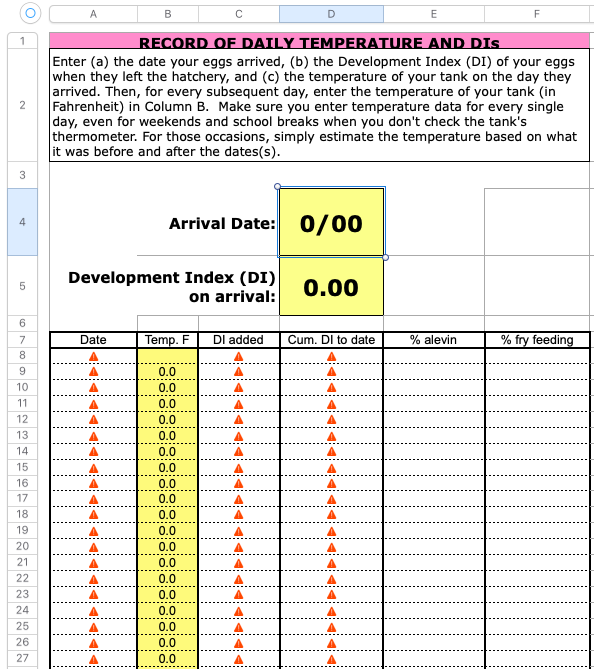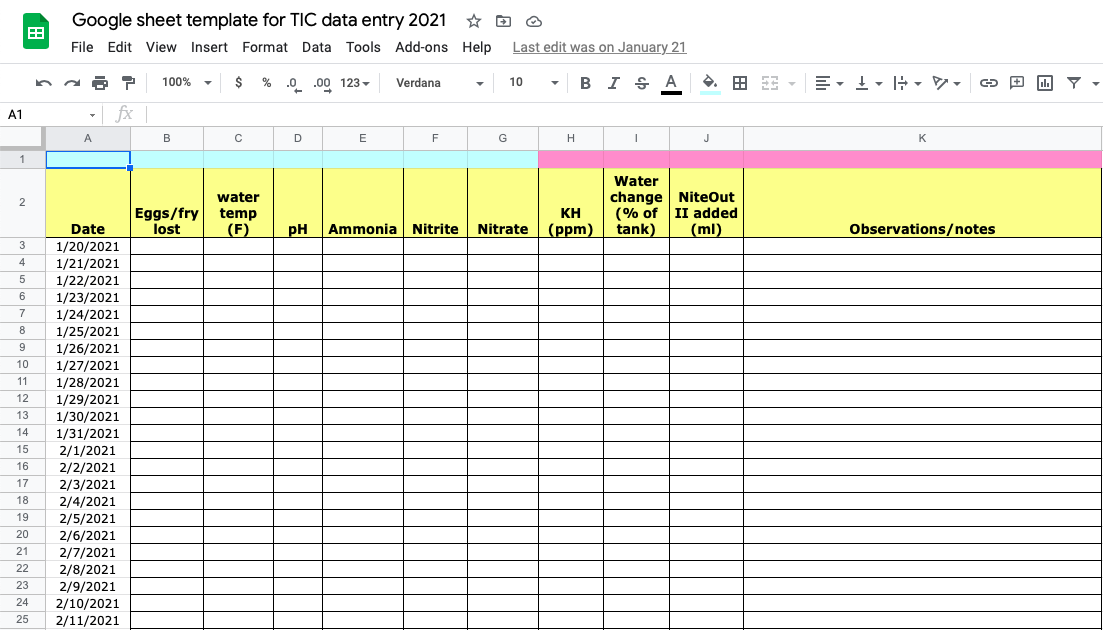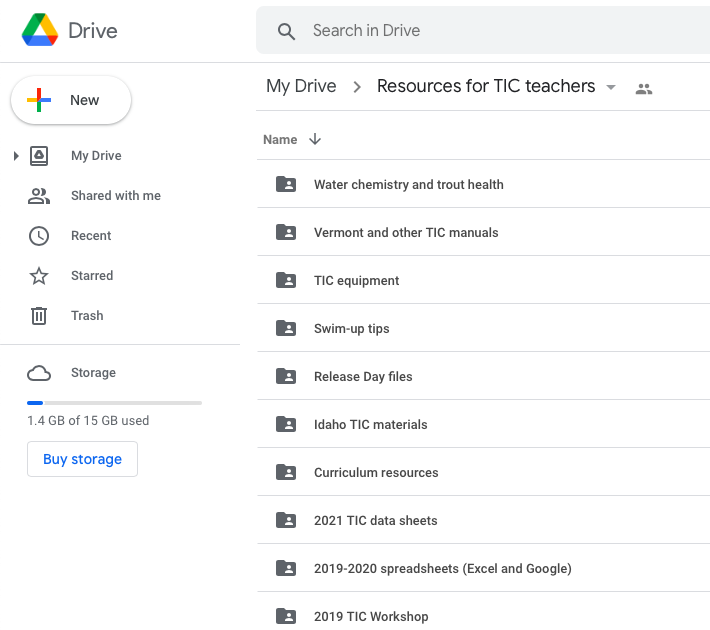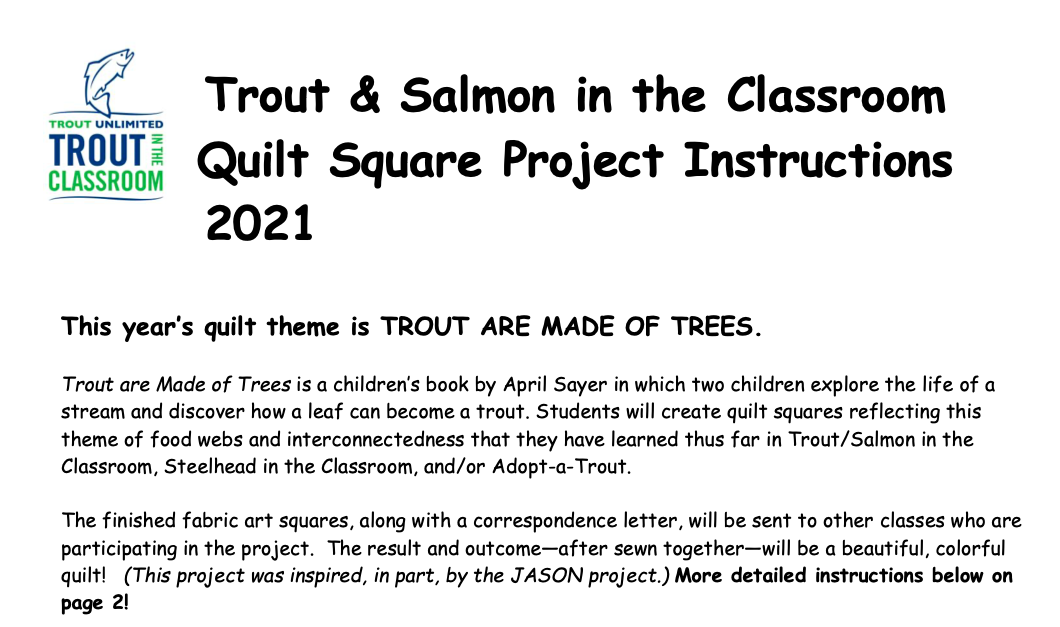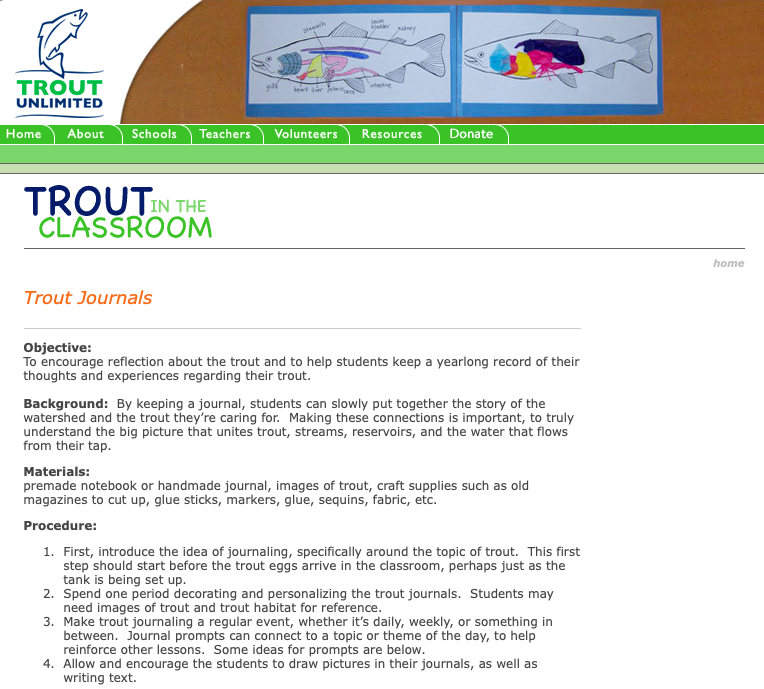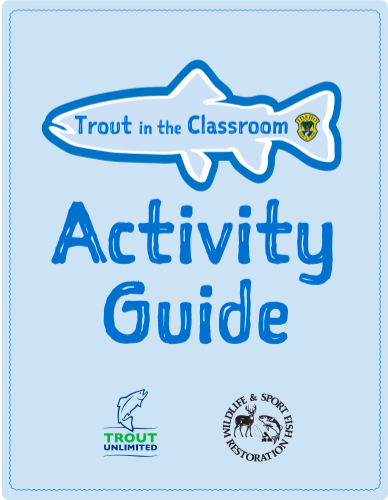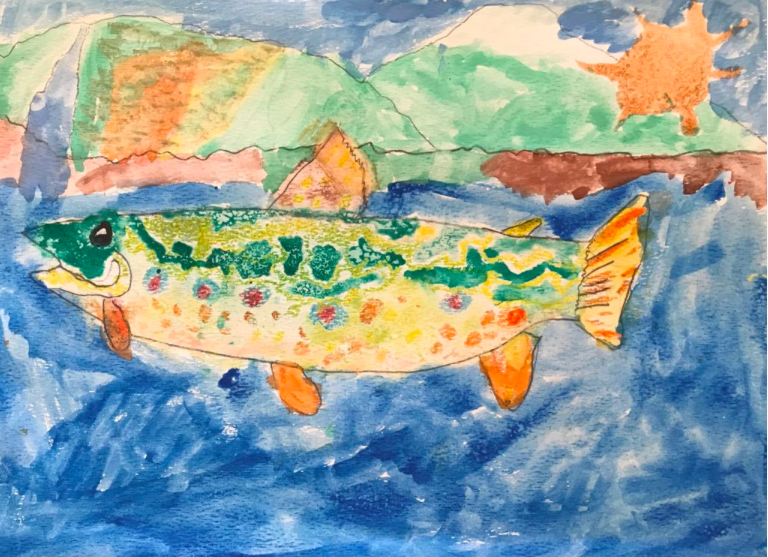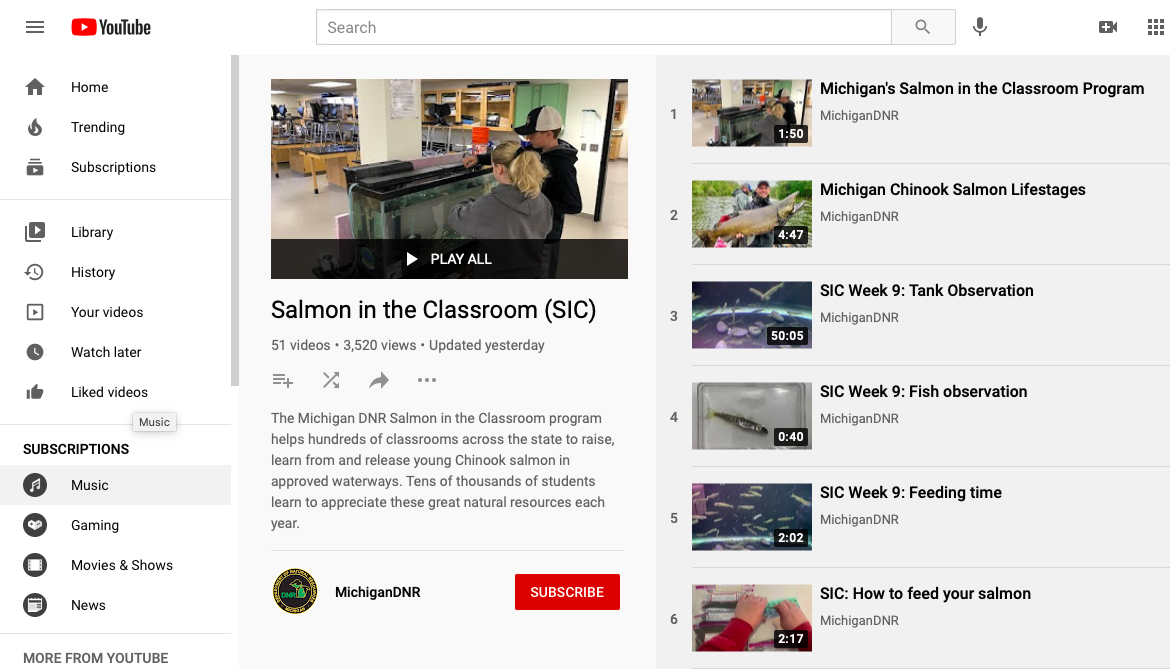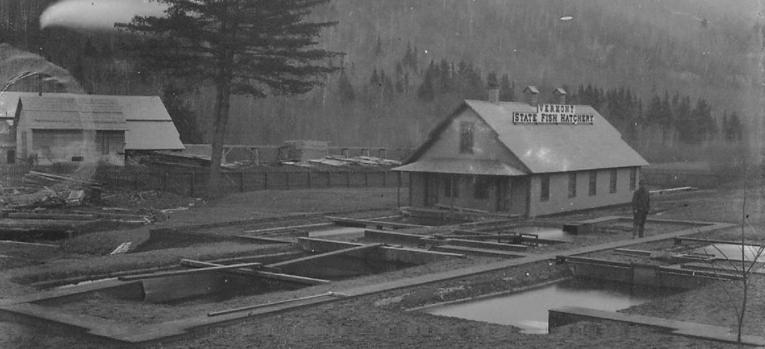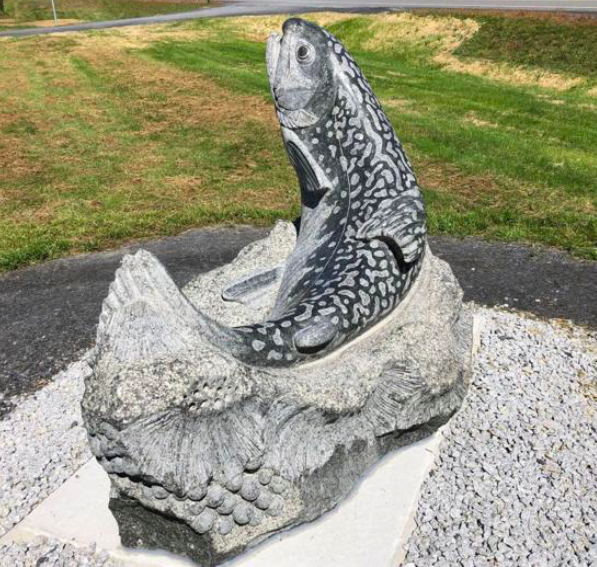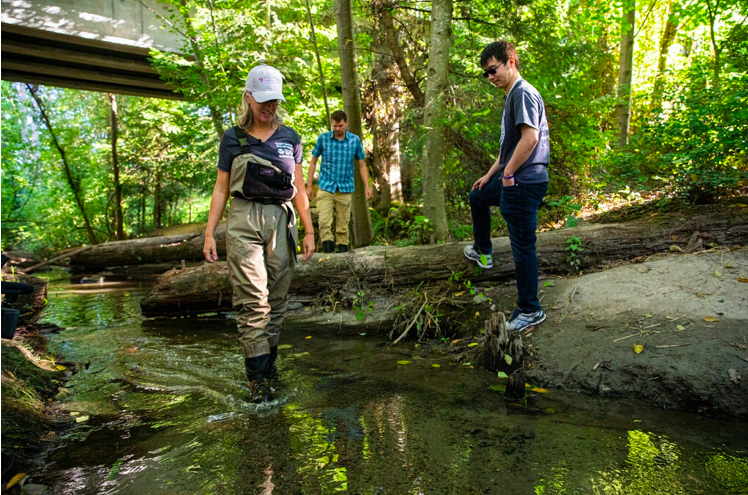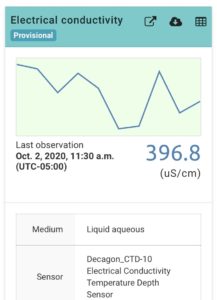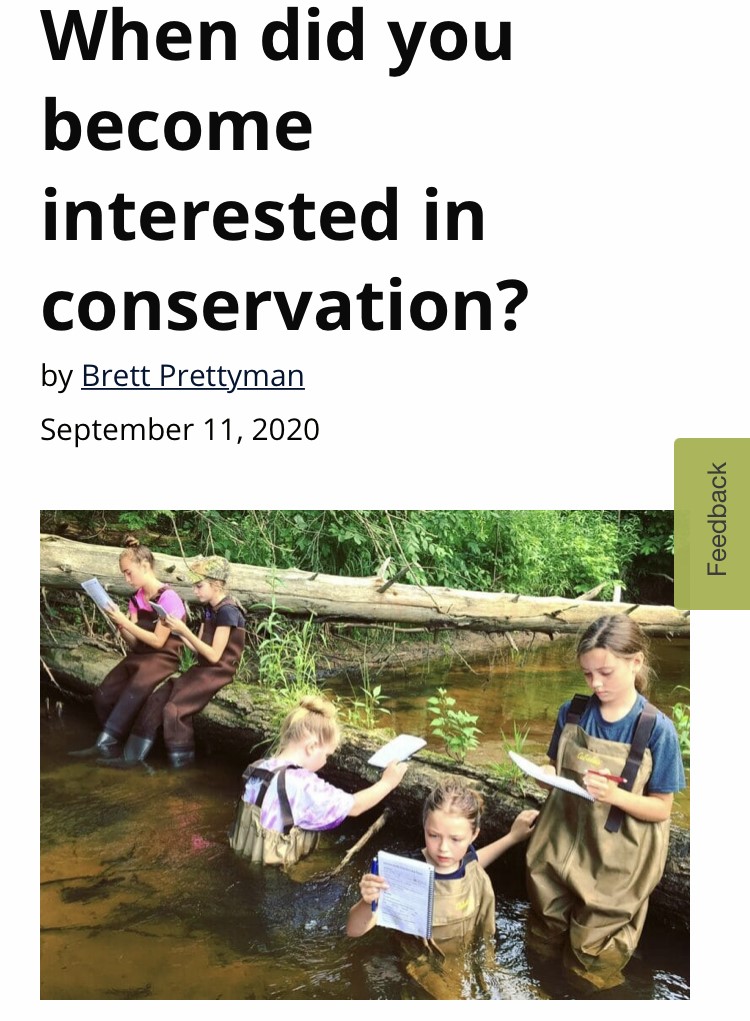2021-2022 blogs and earlier
June 7, 2022
Many Release Days! Student art. End of year clean-up. What about next year?
2022 Release Day photos, videos, and more.
Here’s a great video of the Dorset School RD. It aired on GNAT, the Greater Northshire Access Television network.
Blue Mountain Union School Release Day.
Torie Peters, of Blue Mountain Union School, provided this report and these photos:
We released our trout into the Wells River yesterday! Everything was great and the kids worked really hard to make sure the habitat was appropriate, (shout-out to Matt Buck for lending me some ideas for water testing)! 20 little brookies are now out on their own! The kids were excited to put them in our local river that goes right through all our towns! We released them right where the smaller stream meets the Wells.
[slideshow_deploy id=’1548′]
Riverside School Release Day
Hanna Galinat, of the aptly named Riverside School, sent these photos.
[slideshow_deploy id=’1560′]
Ludlow Elementary School trout art
Lisa Marks sent me these photos of the great trout art her fourth graders produced.
[slideshow_deploy id=’1573′]
Fifth and sixth grade science and math teacher Karli Love shared an album she’d put together of RD photos at her ![]() school.
school. ![]()
![]()
[slideshow_deploy id=’1640′] ![]()
![]()
![]()
![]()
![]()
![]()
![]()
![]()
![]()
Releasing trout raised at Shaftsbury Elementary School
Volunteer Barry Mayer and teacher Kathy Clark sent me pictures from Shaftsbury’s RD. The students were joined by Vermont state game warden Travis Buttle and–I think this is a first–state representative David Durfee,
Barry added this message:
And thanks to Kathy Clark for organizing the parade of 24 students marching from the school about a half mile to the release site on Paran Creek across Rte. 67 from Eagle Square and safely back after an ice cream treat at T & M Enterprises.
[slideshow_deploy id=’1654′]
Neshobe Elementary School Release
Kim Faber and her students enjoyed a good time on the Neshobe River. It wasn’t perfect weather–we did get hit by a brief shower–but the absence of biting insects was a pleasant surprise. Last year they were pretty bad.
Kim had recruited some helpers and created six stations through which her students rotated. Gary Meffe demonstrated fly fishing. Legendary former high school history teacher John Peterson explained the history of the iron foundry the remains of which still sit beside the Neshobe. John was nattily dressed in early 19th century attire. At my station, I described and discussed the key elements of trout habitat. One of the stations Kim took responsibility for was reading the wonderful young-children’s book, Trout Are Made of Trees. (Click the title to find the book on Amazon.) Here are a few photos of the morning.
[slideshow_deploy id=’1659′]
End of year clean-up
Now is the time to clean your equipment before you pack it away securely. Read Chapter 10 of your VTTIC Manual. Those two pages are pretty much all you need. But don’t leave your equipment dirty for the summer. It will be much harder to clean after it’s been sitting around for months.
And if you have food left over, label it properly and store it in a freezer. It might come in handy next spring when your supplies are running low.
FINALLY! SOME QUESTIONS
THIS YEAR
I want to know:
- How many fish did you release?
- Where did you release them?
- When and why did you have your highest mortality?
WHAT ABOUT NEXT YEAR?
I want to know:
- If you plan to continue the TIC program.
- If you’re changing schools or grade levels.
- If anyone else at your school wants to participate in TIC, either with you or on their own.
SO PLEASE RSVP! It’d be nice if you let your TIC liaison know too.
April 24, 2022
Eggs in nature. Videos that show what eggs and alevin look like “in the wild.” Who can help you with your Release Day.
Eggs in nature
There was an interesting article in last weekend’s Rutland Herald-Times Argus. It described how and where various fish species lay their eggs and some of the challenges those eggs face.
The article was reprinted from an issue of Northern Woodlands. Click on the photo of the piece to read the full story.
You can also get a sense of the perils of trout eggs by watching some of the videos we have in the Other Trout Videos collection on this web site. Here’s a three-minute video that shows what trout eggs and alevin look like down in the gravel of a stream.
Here’s a much longer video that is, in my opinion, a classic and a treasure. Produced in 1968, it’s a bit hokey, but the underwater photography is amazing. It portrays many more perils, but interestingly doesn’t hint at environmental factors that could threaten trout.
The WHO of Release Day
Depending on how ambitious your plan is and depending on whether you need volunteers with special knowledge or skills, you’re going to want somewhere between a few and many volunteers to help you. (That’s one of the reasons I’m writing about this almost two months ahead of time.) Here are some categories for potential volunteers/helpers:
- fellow school staff members
- parents and grandparents
- Fish and Wildlife staff (especially for electro-fishing demonstrations)
- Trout Unlimited members
- Audubon Society members
- the local “natural resources conservation district” (Click on the map below to find the NRCD that covers your area.)
- other sportsmen’s groups, e.g., New Haven River Anglers, etc.
- if you have one, the local “watershed group,” e.g., White River Partnership, Friends of the Winooski River, etc. (Click on the map below to see if there is a group in your area. If so, click on the red teardrop to learn its name. Then reach out to them.)
Killington Elementary School video
Mercy Grinold, of Killington Elementary School, sent me this great video of her trout. They look great, don’t they!
April 8, 2022
Trout Camp. Food glorious food! The WHAT of Release Day. And more!
Trout Camp. Sign-up closes April 15.
Every year the State Council of Vermont Trout Unlimited sponsors a wonderful camp for youth 13 – 17. This year’s camp will take place from June 19 to June 23. The deadline for registration, April 15, is fast approaching, so if you know any aspiring fly fishers, you might want to quickly tell them about this terrific opportunity. Click on the license plate above to get more information.
Running out of food. Oh no!
I got an urgent-sounding e-mail from Nicole Comanducci, 2nd grade teacher at Rutland’s Northeast Primary School. She was running out of food.
I didn’t have any, so I e-mailed Dan Wong at the Eisenhower hatchery. We agreed to meet in the Home Depot parking lot. Conveniently, that is quite close to Nicole’s school. I met Dan and one of his USFW colleagues. They had generously brought five or more pounds of fish food, both the “mash” which is what we always start feeding fry, and #2 “crumble,” a slightly coarser food better suited for larger fish. Here’s what 2.16 pounds of mash looks like.
So I am now provisioned to respond to the next emergency that arises.
PS: If, as the end of the TIC season approaches, I find myself with extra food, I label it and date it and put it in a back corner of our freezer. The hope is that I’ll remember it’s there the next time I need some.
Perhaps a release site for Nicole and her students
When I was in Nicole’s room at Northeast Primary, I got to admire her trout (see below).
Her students were very eager to discuss how many fish they still had. One boy was certain that they had 73! I explained that it’s hard to count the fish when they’re swimming loose in the tank, but that they’ll know for sure when they net them out on the morning of Release Day.
While I was in Nicole’s classroom, we talked about where she might release her fish. A beautiful little stream, Tenney Brook, flows off the western slopes of the Green Mountains and passes close to Nicole’s school before going through a residential neighborhood. Then, via East Creek, it flows into Otter Creek, which ultimately dumps into Lake Champlain northwest of Vergennes.
On its way to East Creek, Tenney Brook becomes the northern edge of Rutland’s Rotary Park. I thought that might be a good release site. Here are two photos. The top one shows you what this great little stream looks like: just the right amount of water, rocks on the bottom to provide “structure,” woody debris and larger rocks on the far edge providing hiding places for young fry.
The second photo reveals the urban environment through which this trout stream flows. You never know where you’re going to find trout habitat!
Here are a few photos of some of Nicole’s student and their TIC projects.
[slideshow_deploy id=’1517′]
The WHAT of Release Day
Release days can be big or small, simple or complicated. Most release days span about two-and-a-half to three hours, but some take less than half an hour. In the past, Castleton Village School’s Guy Merolle connected his RD to an annual all-school event that involves students and teachers traveling to a local state park to learn about and pull invasive plants. On the way to the park, the school bus stopped at the release stream; everyone de-boarded; Guy spoke about the history of the CVS project and what they had learned; designated students released the seven remaining trout; people took pictures; everybody cheered; and students got back on the bus and headed for their service-learning project. This kind of “minimalist” approach to Release Day made sense for CVS because Guy has his students doing research on the Castleton River, which is within walking distance of the school, all year long.
Here’s a picture of Guy and his students.
This web site has several YouTube videos of RDs at different schools, some in Vermont, some elsewhere. (The last one is a bit quirky, but it may give you ideas,) If you search on YouTube, you’ll find even more. Our TIC manual has a separate section on RDs with lots of great information/suggestions. In the latest manual edition, it’s Chapter 9.
Here’s a link to the RD videos on this site:
Simple, brief releases are self-evident, and I’m sure you don’t need my suggestions for those. Just be sure you’ve followed the guidelines in my last blog for the where of RDs, especially those related to safety.
If you have the time and want to plan a longer and more multi-faceted RD and if you can get the volunteer help, here are a few ideas.
- Teach students how to analyze the release stream, finding its runs, pools, pockets, and riffles as well as its woody debris, underwater structure/protection, and the trees and shrubs that shield young trout from predators and excessive sunlight.
- Study and evaluate the quality of the “riparian zone” (if you don’t know what that is, look it up; it’s very important).
- Collect and classify macrovertebrates. (Look for the macros charts within the Insect identification charts folder in the TIC Resources collection. Print these in color on card stock and laminate them. In a future blog, I’ll offer suggestions on inexpensive equipment that your students can use for macro collecting.)
- Use the “macros” data your students generated to calculate the stream’s “biotic index,” a measure of its health. (Check the same folder mentioned above to find one or two biotic index worksheets.)
- Estimate the volume of the stream.
- Measure the speed of the stream.
- Test stream water, including for phosphates.
- After doing 5 through 7 above, you could, if you wanted, have students of a certain academic age calculate the “phosphate load” being delivered from that point on the stream to the watershed below.
- And perhaps the piece de resistance: “electro-fishing.” This, usually conducted by a Fish and Wildlife staff person, involves putting an electrified probe into the water to temporarily stun fish so that you can examine and measure them, etc. It’s always a hugely popular demonstration.
In addition, if you’re very fortunate in terms of the resources/opportunities of the release site and if you’ve found the right volunteers, here are some further possibilities.
One of our TU volunteers worked at Hawk Mountain Resort, which allowed a local school to use their grounds as a release site. Thus, their students were able to:
- collect and classify macro invertebrates in the bordering Black River,
- feed the 12″ rainbows in the resort pond,
- have a rudimentary fly casting lesson at the pond (Orvis lent 15 fly rod and reel outfits),
- hike the resort trails to a beaver pond, wetland, and other diverse habitats, and
- have a picnic on the resort grounds.
Clearly, this kind of opportunity won’t be available to the vast majority of schools, but this list may give you an idea of what could be possible under the right circumstances.
Finally, you’ll want to release your fish. Releasing your fish as the last activity of the day allows tension and excitement to build.
If you have only a very few fish, you could have one student, on behalf of the whole class, release them all. That student could be chosen by lottery, elected by the class, or the student who, on a basis of a point system you designed, won the honor.
Many classes have enough trout to allow each student to release at least one fish. Sometimes, the RD plan is group-based, and, in that case, each group may be allocated a percentage of the total number and allowed to decide how their group wants to do the release.
However you choose to approach it, it’s desirable to get everyone together at the end and ask for reflections/reports, and perhaps to celebrate with a cake or cupcakes.
Reports from the field
Volunteer Chuck Goller sent me this report from Sandy Fary, of Camels Hump Middle School:
Hi Chuck,
Thanks for checking in. We have some larger trout and some teeny tiny fish that like to hide in the rocks. In total, our numbers are at 15. Finally, we have poop trails coming from our fry (see picture)!Luckily, Gerry and I plan to split the number of trout that we have remaining by release day.For the Sequoia Team, we plan to have our Release Day at the brook along the Birds of Vermont Museum. We will have Walt Poleman to discuss the relationship between birds and brook trout, Jens Hilke to talk about the necessity of healthy riparian buffers, Chuck (?) to teach fly fishing, and Sandy to do activities about survival rates.
March 30, 2022
Release Day planning
Let’s talk about Release Day
While the temperatures around the state have been fairly cold, with nighttime temperatures often in the teens, it’s not too soon to start planning for your Release Day. There are many topics to address, but for the most part they fall into the questions WHEN, WHERE, WHAT, and WHO. Let’s take them in turn. I’ll address the first two of these in today’s blog and cover the third and fourth in my next blog. But first, you might want to see a video about one of Mary Hogan School’s Release Days.
Here’s a link to a page on our VTTIC web site that contains several Release Day videos, and almost certainly you can find additional RD reports on YouTube.
WHEN. We advise schools to hold their release days between the middle of May and the middle of June. Before the middle of May, we can still get cold days. After the middle of June–well, you’ll be starting your summer break. We also advise that you schedule a backup to your first-choice date. A heavy rain just before your planned release day could raise water levels so much that it would be dangerous for children to enter the stream. Take a look at these. Here’s what beautiful Mad Tom Brook in East Dorset looks like most of the time.
Here’s what it looks like at flood stage.
WHERE. My favorite release sites have these attributes:
- A stream that holds trout, that is, with clean water that stays relatively cool (less than 65 degrees) throughout the summer.
- A small stream, ideally three to eight feet wide with most pools not much more than a foot deep.
- Unless you’re able to walk to your site, a location where you can safely park school busses and volunteers’ cars. The best sites won’t require your students to cross a busy road to get to and from the stream.
- A site that doesn’t require anyone to descend a steep bank to get to the water.
- An area near the release site where you can gather students and volunteers to explain the day’s activities, read poems and essays, have refreshments, etc.
Here are some examples of streams that would be good to visit on your Release Day.
[slideshow_deploy id=’1480′]
If you need help finding a good release site, reach out to people who fish in the streams of your area or to your local TIC volunteer.
N.B.: If you decide you’d like to release your fish on private land, make sure you get permission.
March 19, 2022
Fish dissection. Web sites about trout anatomy. Cold water and its source. Amy Clapp’s video series. And a swimming two-headed trout.
Learning about fish anatomy through dissection
While our streams and their aquatic life are still mostly asleep, this is a good time to have your students study the anatomy and physiology of fish by dissecting them. You would probably find it difficult to acquire a dead trout for that purpose, but ice fishing season is a terrific time to get other species, especially panfish like yellow perch, bluegills, and crappies. Ask your friends and colleagues if they know ice fishermen. Then ask one or more of those individuals if they would be willing to donate some of their catch. (In some parts of the state you’ll find businesses that buy fish caught by ice fishermen. If you’ve got one of those in your area, you can probably inexpensively purchase the fish you need.) Having one fish for every two students would be about right.
Here’s a six-minute YouTube video of a trout external and internal anatomy that’s designed for older students.
If you search YouTube for “trout dissection,” you’ll find many more. You’ll also find a few other dissection videos and a whole lot more on the Other Trout Videos (that’s a link) of the VTTIC web site (that’s a link too). If you don’t feel comfortable leading a dissection activity by yourself, your regional TIC coordinator may be able to recruit a TU volunteer who can help.
More on anatomy
Jenny Hewitt, of Barnard Academy, sent this question.
My fourth and fifth graders in Barnard are doing some research projects on trout. Two are researching internal anatomy. They are having a hard time finding information. Some of the questions they have are about the trout brain, heart, liver and intestines. They are wondering if the trout heart works the same as the human heart. They know it pumps blood.Also wondering if the swim bladder is attached to the stomach or intestines.Do you know of any sources that might be accessible for upper elementary students ? They could even be a bit more advanced as they could read with support.
Dan also sent a link to a slideshow that compares fish and human circulatory systems. Click on the image below to see it.
And then I got a couple more web sites from Dartmouth professor and TIC man of science Robb Cramer. The first describes how you can use a microscope to learn about a goldfish’s blood circulation.
This next one, also from Robb, explains fish respiration.
Thanks, Robb. Feel free to share the great web sites and videos you come across.
Cold water and its source
A recent Trout Unlimited publication carried an interesting piece about the importance of cold water for trout, especially brook trout. The research being conducted in New Jersey is set against the backdrop of impending climate change. Click on the graphic to read about it. PS: There’s also a great imbedded YouTube video of brook trout spawning in NH.
And where does that critically important cold water come from? That’s a long story, but let’s dip our toe into it.
Several years ago, my friend Chuck Dinkel, TIC coordinator in MD, wanted to visit Vermont and fish with me. The only problem was that it was July of a particularly hot summer. Since catch-and-release fishermen, like we are, need to stop fishing when the water is more than 65 degrees, I began taking the temperature of the waters I usually fish. Stream after stream measured above 70. I e-mailed friends up north, and they reported similar conditions. Clark Amadon, TIC coordinator for the Mad Dog chapter, said the Dog River, which he fishes often, was in the 80s!
All the streams I’d checked were 10 to 30 miles from my house, and all were very warm. Then I decided to throw my thermometer into the Castleton River, within walking distance of my home. It was 55 degrees! And when I checked it half a mile upstream, ir was 51! What is going on? There must be many powerful springs cooling the water.
A few weeks later, my friend Joe Kraus and I decided to locate the springs. We entered the river at an upstream point and found that the water was 78 degrees. We walked downstream, and every minute or two, I’d drop my thermometer into the river. Pretty much the same. Then at one point, I said, “Joe, I don’t need to use my thermometer.” My ankles registered the cold water. For the next 50 yards or so, dozens of springs pumped their frigid water into the stream. Here’s a video of some of the springs bubbling up through the sand and fine gravel on the bottom of the Castleton River.
Here’s another fascinating fact. In my area of Vermont “ground water” or water bubbling out of springs typically comes out of the earth at 48 degrees. It is said that the temperature of ground water equals the average annual temperature of that longitude and latitude. So, if you added the temperatures of every hour on every day across the year and divided the total by 8,544 (24 hours X 356 days), you’d get 48 degrees. Try it!
So where does spring water come from? Perhaps in a future blog I’ll dive into the fascinating and important topic of the aquifers that lie under Vermont and their critical role in keeping our trout streams cool.
Amy Clapp’s video series
A couple of years ago, I shared the terrific “phenology” (you may have to look that up) videos that former Castleton Village School teacher Guy Merolle produced for his students. Here’s a link to Guy’s videos. Unfortunately Guy was transferred to Fair Haven Union High School and no longer participates in the TIC program.
But Amy Clapp, at Salisbury Community School, is doing something very similar. Here’s the message she sent me earlier this month.
Hi Joe,Every week I send videos out to teachers all over the state highlighting different things happening in Vermont in nature that week. I thought you might enjoy the one from last week…..TIC gets some credit at the end!
And then she attached a link to that week’s video. That’s here.
Two-headed trout
I’ve seen lots of photos of two headed trout, but this video, sent to me by Karli Love, at the Dorset School, is the first I’ve seen of such a fish in action.
March 7, 2022
Fairfax MS to the rescue! Pictures and movies of fish. Fry die-off. Ice-out. More water chemistry questions. Deformed fish. What’s “normal” mortality?
The Castleton River at flood stage on Monday, March 7, 2022.
Nice TIC video
Volunteer Chuck Goller forwarded me this video that Browns River Middle School’s Amie Fisher sent him on 3-2-22. Amie’s fish look active and healthy.
Chuck also forwarded these beautiful photos that Lisa Windhausen, of Browns River Middle School sent him. Enjoy!
[slideshow_deploy id=’1412′]
Fish rescue
On the afternoon of the Friday before winter break, Erica Guralnick, of Georgia Elementary and Middle School, reached out to me to report that her tank had sprung a leak and that all but six of her trout were dead. What to do–especially with only a precious few hours before everyone was going to be gone for the week?? I contacted TIC teachers in that area, and miraculously, Ben Psaros, of Fairfax Middle School, contacted his colleague Justin Brown, who agreed to meet Erica before the end of the school day. Phew! Thanks everybody for being so helpful and responsive!! Erica will now try to get a new tank and set it up. Then we’ll see about getting her some replacement fish.
Mortality rates during swim-up
Torie Peters, of Blue Mountain Union School, sent this inquiry:
Question about how many dying fish is normal during the swim up stage. I know some won’t ever learn to eat on their own, but I have plucked about 12 out in the last week and I’m noticing more and more just lying on the bottom. They are not dead but definitely are not lively and are not feeding like the others.
Here was my response:
There really is no “normal,” Torie. Some teachers manage to catch the swim-up and have virtually no “pinheads.” Others miss the swim-up completely and lose just about all their fish.
What we have learned is that the alevin that haven’t learned to eat are pretty much goners. They languish on the bottom and get skinnier and skinnier. At that stage they should be removed.I hope some of yours survive. Let me know how they do.
The challenges of the swim-up stage are why we call this time of year March Madness!
“Ice-out” on a Colorado river
The photo at the top of this blog post shows an ice-free river on a rainy day when there’s also been a lot of snow melting, but around the state, especially in northern sections, many Vermont rivers may still be ice-bound. Every year, however, when the conditions are right, that river ice will break up. Here’s what that can look like.
Now imagine the trout in that river. How are they handling that deluge of all those heavy, scouring chunks of ice? Ask your students to think about that.
Letting your fry out of the breeder basket
Jeff Rouleau, of St. Albans City School, wanted to know when to let his fry out of the breeder basket. At that point, it had been about two and a half weeks since his fish began swimming up. He also sent this great photo.
Here’s what I told him:
Most of them look great; some seem quite big, but I can’t tell from the photo whether you’ve got some smaller ones that are clinging to the bottom. If that is the case, then I’d keep at least the littlest one in the basket for another week.
It certainly would be fine to net the two-thirds or more who seem big and strong and transfer them to their brave new world.
Deformities
Quite a few teachers have sent me photos, including some of their deformed fish. Here are two. The photo of the two-headed fish is from Scott Pease, at Lyman C. Hunt Middle School. The “conjoined fish”–something I’ve never seen before–comes from Lisa Marks, at Ludlow Elementary School.
And Karly Love, of the Dorset School sent this video of her double-header.
Thanks to those teachers for their submissions.
Air-borne fry!!!
On Friday, Cindy Mosedale, of Newark Street School, sent volunteer Clark Amadon and me this report.
We returned to school this Wednesday and yesterday a student noticed a trout being projected out of the brooder basket into the aquarium. Yikes!After school, I worked with some student volunteers to overhaul the aquarium. Here’s our synopsis.
The diffuser was causing air bubbles to accrue under the brooder basket
The air bubbles would burst about every ten minutes
The fish by the surface were getting launched into the big tank by the resulting ‘tsunami’
All would have been fine, except we were missing a spongy cover for the filter intake (my own oversight when trying to locate missing parts and resurrect the aquarium) and the fish were getting sucked up into the filter. Many died, many were still alive, but stranded in the bottom of the filter. We did a complete aquarium overhaul and rescued the stranded fish.
The undetected dead fish caused slime to grow in/around the tank – not good! This was cleaned as best possible. Water changes will continue every few days to help clean the system out. Slimy stuff was found on the aquarium plumbing, however all water quality tests had been fine. A mushroom was even found on the styrofoam cover! Is this because of the fish or because of the mushrooms we had collected and placed on the shelf last fall?
My response:
Wow! Thant’s quite a story, Cindy, and an excellent narration!If you haven’t already, relocate the breeder basket and/or the airstone so that you no longer get that build-up of air bobbles.If you haven’t already, get some screening on that filter intake. I recommend nylon screening with 16 holes to an inch. You can attach it with twist ties or rubber bands. Zip-ties work too but are harder to remove if you want to clean the screening.Try to stay on top of that slime.A mushroom!! I’ll bet it is, as you suggest, the result of spores from last fall’s mushrooms. (BTW, what kind did you collect?)
Cindy sent these pictures of mushrooms her students collected last fall.
Felted fish??
I also got another photo from Scott Pease, this of his so-called “felted fish.” What are these attractive things and how did his students make them? I do like them though.
February 15, 2022
TIC slide show. Swimming up fry abound! Trout illness. Water chemistry issues. Vacation feeding practices. Insulation??
Slide show
Ben Psaros and some of his 7th graders at BFA Fairfax Middle School are building a TIC slide show. Check it out by clicking on the image below.
Swim up!
We’re getting lots of reports from teachers whose fish are swimming up. Here‘s a photo Charlie Cummings of Fisher Elementary School sent me.
You’ll see that some of Charlie’s alevin are still down on the bottom while others are well up in the water column. This is typical in the early stages of “swim up.” You’ll also notice that at least a couple of the Fisher are already putting on weight. That too is normal and can sometimes result in great size differences between the smallest and the largest fry. That’s one of the reasons we urge teachers to keep their fish in the breeder baskets for at least two weeks after all the fry are feeding regularly. Releasing them into the tank too soon often results in the small and less assertive fish languishing on the bottom and not getting enough to eat while their more aggressive brothers and sisters just get bigger and fatter, gobbling up all the food before it gets down to the skinny guys.
How often to feed? You can feed your fish as often as seven times a day. That’s what they do at the hatchery. But just feed them a little bit each time. Ideally, within ten minutes the fish will eat all the food you’ve given them. If not, remove the uneaten food by using either your siphon or a small net.
Disease at Miller’s Run School
Mary Jardine, at Miller’s Run School, was concerned about a couple of her alevin and shared these photos of them.
[slideshow_deploy id=’1362′]
Here’s what she wrote:
I have a couple fry that are not swimming like the others and I noticed their bellies seem a bit swollen and/or have a white-ish ball. Is this something to be concerned about? Should I remove them?
I sent those pictures to some of our available trout experts, and here’s what Tom Jones, of Vermont Fish and Wildlife, said in response;
Hi Mary! I work as a fish pathologist with VT F&W. The pictures of your abnormal brook trout sac-fry were forwarded to me, and the condition appears to be Coagulated Yolk Disease (White Spot Disease). It is a very common condition in trout and salmon aquaculture. Most fish that have severe cases of it usually don’t survive. My recommendation to you is to remove and euthanize the few that have the yolk-sac disorder. Many things have been reported to cause this type of condition to include but not limited to bacterial infection, fungal infection, physical injury to the yolk-sac (possible abrasion to the exterior of sac, often leading to opportunistic bacteria and fungi), poor water quality factors during incubation and early sac-fry environment. There is no treatment once seen other than providing optimal water quality conditions and rearing environment for the fry.
I’ve attached a short piece from Alaska that gives some good information.
Water chemistry issues
Torie Peters, of Blue Mountain Union School, sent this update on her tank.
- Every time I test, ammonia has been extremely low.
- Over the past couple weeks I have seen nitrite and nitrate creep upwards. Nitrate is currently sitting at a 3. Nitrate is currently around 20, but has been higher, like around 40.
- I have done two separate 5(ish) gallon water changes, (Feb 7 & 11) because I was worried about pH, NO2 & NO3
Here’s what I told Torie:
Nitrite is as much a worry as ammonia. You should try to keep it at 1 ppm if not lower. Typically that requires water changes. To get it down to 1 ppm may require at least two significant water changes. Depending on the age of your kids, that can be a good exercise in practical fractions/proportions.
Dartmouth professor Robb Cramer added this:
Keep the tank as clean as possible. If there’s any debris, vacuum it up and check the filter regularly. As Joe said, nitrite is really the one we worry about. The good news is you have all the bacteria in there if you are seeing Nitrate.
As Joe said, water changes are the solution to get the nitrite down below 1 PPM — and then keep as clean a tank as possible :-).
What to do over vacation?
BFA Fairfax Middle School teacher Ben Psaros asked this question:
“I am hoping to get some information for next steps. Our alevin have turned to fry and are up and feeding 3x/day. Tank chemistry is consistent and temps are between 51-53F weekly. As far as next steps and feeding over break, what shall I be doing? Do I need to come in and feed daily, or every other day? Can I let the fry out of the breeder basket and into the large tank?”
TIC volunteer Chuck Goller responded with this:
Hi Ben,
You don’t need to feed them every day over break. Every other day is great or every 3rd day would do if you can’t hit every other day.
Your fry are just going to be feeding for two weeks this Saturday. We usually recommend not releasing them until all have been feeding for two weeks. You can release them if they are all strongly swimming up and feeding. If you have some who are lingering at the bottom of the basket, I would leave them in the basket a bit longer.
There is no real disadvantage to leaving them in the basket while the advantages are it is easier for them to find and swim up to the food and they are less likely to get sucked up against the filter intake mesh.
Chuck’s reply reminds me to remind you to make sure your filter intake is covered with fine–but not too fine–netting or screening. See pages 16 and 71 of the VTTIC Manual. The optimal coarseness of the screening would be approximately sixteen holes per inch. See below.
Insulation??
Melissa Hunkins, of Peoples Academy, asked this question, “My trout have been swimming up now for a couple days and I am just curious if I need to keep putting insulation back on every night or do I keep it off?”
Here’s how I responded:
You don’t need to put the insulation back on at night. Most teachers do so, however, for two reasons: to lower cooling costs (this also reduces wear on your chiller) and to reduce condensation buildup. Depending on how warm and humid your classroom is, sometimes condensation is so considerable as to create a slow flow that drips onto the floor.
January 25, 2022
More on power outages during winter storms. An art contest for K-8 kids.
Green Mountain Power text alerts
The Green Mountain Power company, which serves most of the state, offers text alerts when there’s a power outage. Here’s a map of their service area.
If your school gets its electricity from GMP, consider signing up to be notified if your power goes out. Here’s a link to the web page where you can sign up for text alerts.
Generic power outage notification service
While the free GMP service described above works only if you’re living in an area where GMP provides electricity, here’s a product that should work almost anywhere.
iSocket requires both that you buy a device–as you can see, for $199 for the minimum configuration–and that you pay for an annual subscription fee. (Click on image above to visit their web site.) The basic fee is $47.88 per year or $3.99 a month. This gets you unlimited e-mail notifications of power outages. If you prefer to be notified by text or voice messages, those cost $0.09 per message. iSocket also provides services such as ambient temperature monitoring (a one-time $9.00 add-on) and an external temperature sensor designed to be installed in a fish tank (a one-time $30.60 add-on).
It looks interesting!
Here may be an even less expensive way to get notified!
I found this product “GFI Notify” that could be the least expensive way to learn that your power has gone out. Click the screenshot below to visit the web site and learn more.
Here’s what the web site says about the product:
With GFI Notify, once installed, you will receive a power outage notification via email and text within 5-6 minutes when a GFI trip occurs, giving you plenty of time to take remedial action. Notifications will also be sent if any additional monitored circuits lose power. Up to 3 contacts will be notified at the same time. And now, as an extra bonus, you will receive with your order two FREE SmartPlugs. With GFI Notify, you will be notified if just a single circuit has lost power or if the power is out to the entire premises.
Please Note: GFI Notify can monitor any electrical outlet (or circuit), whether it’s a GFI outlet or not, and will provide power outage detection and notification. Even for a dedicated circuit, having a power failure notification can be important. If the power to an aquarium, for example, goes out, being quickly notified will be extremely important. And, you will also be notified when the power comes back on.
DIY power outage notification!
Finally, I found an interesting YouTube video that provided details on how to make your own power outage notification device. If you have a technological orientation or know a teenager who does, you may want to give this a try. It could be an inexpensive way to get a call whenever your power goes out.
Vermont Urban and Community Forestry art contest
Children are invited to submit artwork and a written story to a competition focused on the trees in our lives. The contest is open to children in grades K through 8. The deadline is March 11, 2022. Click the image below to access a web site with further details.
January 19, 2022
Preparing for winter storms, more delivery photos
Most regions of the state had their first significant snowfall yesterday. A few areas lost power too. These conditions can be trying times for TIC programs, especially unprepared ones. So how do you make sure you’re one of the prepared ones?
- PLANNING FOR A POWER OUTAGE:

- First, check to see if you have your tank equipment plugged into a GFI receptacle. Those look like the white image to the right. They are designed for safety, but also can create problems for TIC programs in the event of even the briefest power outage. What happens when you have a “normal” (old-style receptacle) is that the power to your equipment will be interrupted until electricity is restored. Once it is, your pump, chiller, and aerator will begin working again. A GFI receptacle, however, has to be reset by hand. Ideally, your school’s maintenance staff might be willing to remove the GFI receptacle and install a regular one instead. If not, you’ll need to be notified ASAP when there’s a power outage. In that situation, either you or someone else (your custodian?) will need to go to your classroom as soon as the power returns and reset the receptacle (One of those two white rectangles in the middile of the receptacle–usually the top one–is the reset button. Press it in firmly.)
- Second, have lots of ice on hand in case your power, and hence your chiller, is off for a long time. Most teachers freeze unchlorinated water in several plastic bottles and store them in a freezer at school. You can either use tank water, water treated with NovAqua Plus, or stream water. Fill the bottles only three-quarters full. Otherwise, when the water freezes, it may blow the top off the bottle.
- Third. Consider picking up a battery-powered aerator.
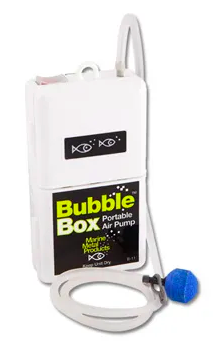 These inexpensive devices are widely available on the Internet but also in fishing supply stores and even Walmart, where I found one for $12.99. They’re not necessary if your power is back on after two or three hours; but, if you happen to lose power for twelve hours or more, they may help keep your fry alive. Some of you may recall that over the last decades, various regions of the state have lost power for multiple days. A single battery-powered aerator may be insufficient to adequately aerate a 55-gallon tank (two might do it), but in an emergency you could transfer your fry to a five-gallon bucket and aerate (and keep them cool) them there. Battery-powered aerators can also come in handy on Release Day, especially if you anticipate having your fry in a cooler for several hours before releasing them into your stream.
These inexpensive devices are widely available on the Internet but also in fishing supply stores and even Walmart, where I found one for $12.99. They’re not necessary if your power is back on after two or three hours; but, if you happen to lose power for twelve hours or more, they may help keep your fry alive. Some of you may recall that over the last decades, various regions of the state have lost power for multiple days. A single battery-powered aerator may be insufficient to adequately aerate a 55-gallon tank (two might do it), but in an emergency you could transfer your fry to a five-gallon bucket and aerate (and keep them cool) them there. Battery-powered aerators can also come in handy on Release Day, especially if you anticipate having your fry in a cooler for several hours before releasing them into your stream.
More reports on Delivery Day
Nicole Comanducci, of Rutland’s Northeast Primary School, sent me two short videos and several pictures of delivery day at her school. Here Nicole’s videos.
And here’s a slideshow made of the photos Nicole sent me.
[slideshow_deploy id=’1344′]
January 13, 2022
Taking care of your eggs, important TIC spreadsheets, more delivery photos
Danielle Fagan, of Proctor Elementary School, sent me a few pictures of Egg Delivery Day in Proctor. Here are three.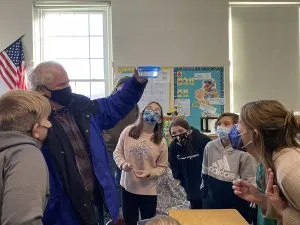
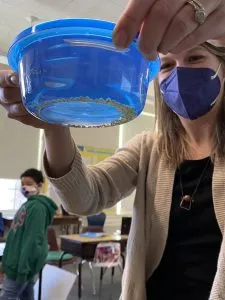
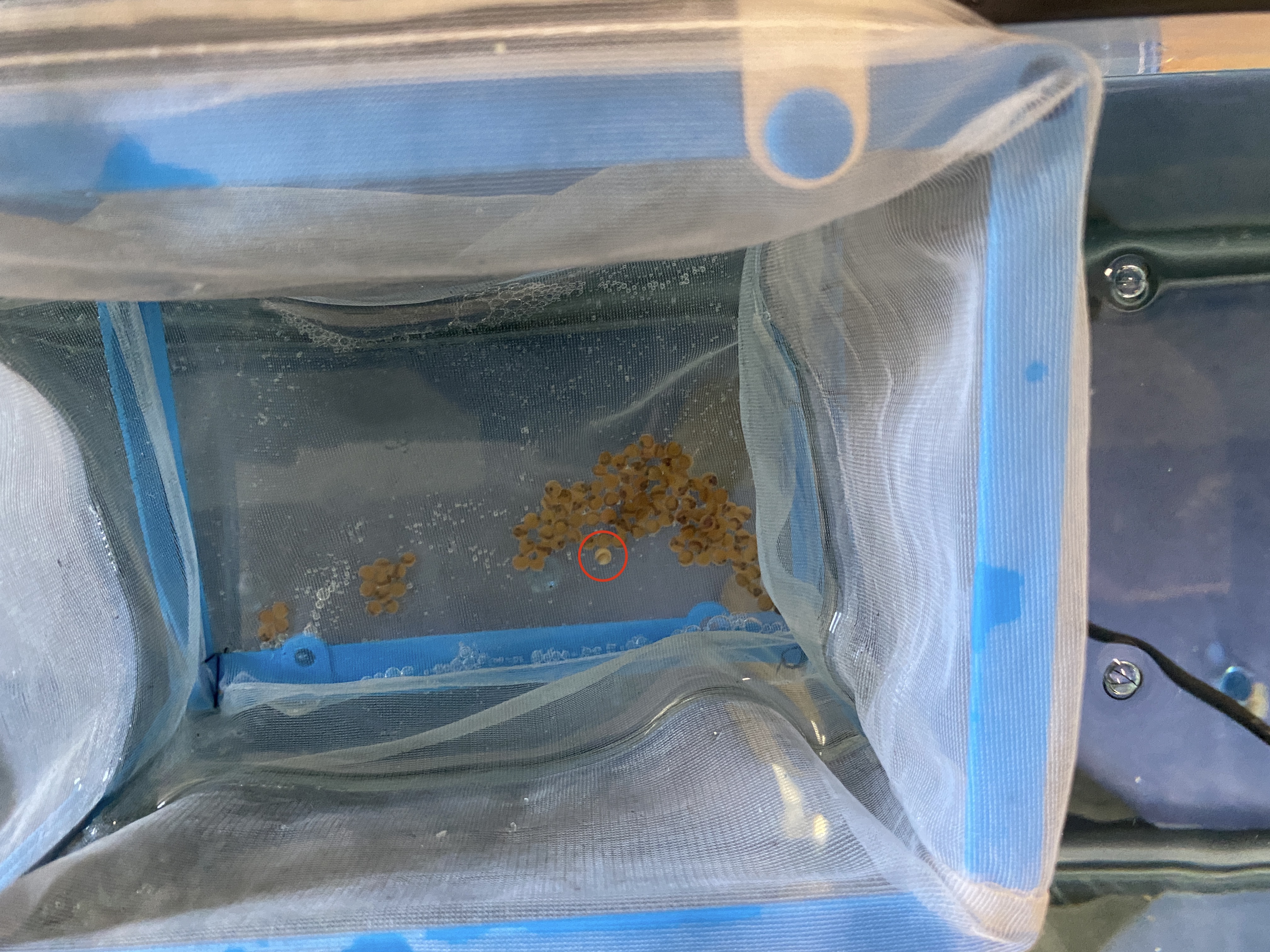
When I saw that third photo, the one of the eggs in the breeder basket, I had a question, so I zoomed in.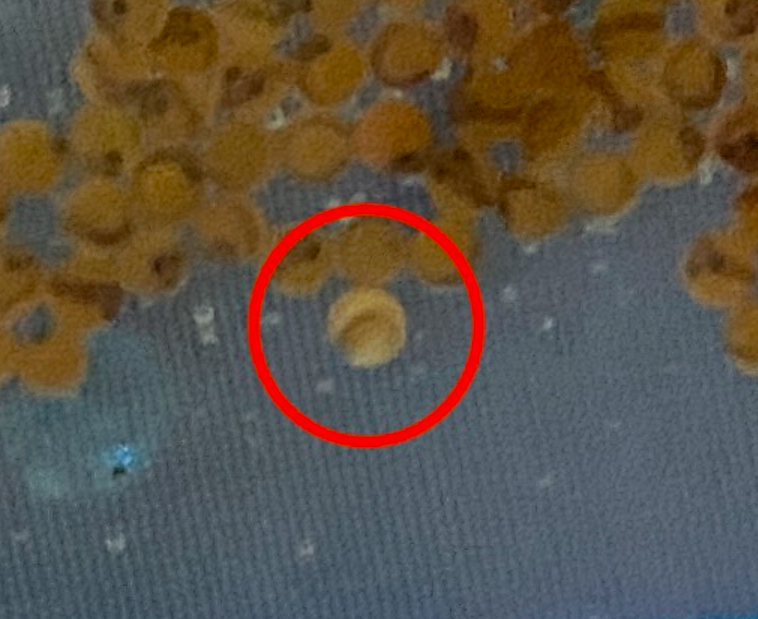
See that light-colored egg? That might be one that has died or is dying. If so, it needs to be removed. Use your turkey baster to do that.
Then I got a message from Angela Selvaggio care of Clark Amadon. She asked,
Has anyone else already pulled out a couple of eggs because of the white fungus?
Subsequently, Cynthia Fortin reported,
I also was looking at my eggs today and many of them have a whitish look. I am worried that I will lose many of my eggs so early in the process.
What does this add up to? You have to watch your eggs very carefully during this period. Here’s some advice:
- Inspect your eggs at least once a day at this stage.
- Look for dead eggs and remove them. These will appear opaque or cloudy compared to the healthy eggs.
- Remove any fuzzy white material as well as eggs that have fuzzy white material on them. (see “St. Ann Science” blog, which contains some good photos, and YouTube video below)
- Remove all egg shells of hatched eggs. (Now do you see why we keep eggs in the breeder basket? It would be much harder to monitor the eggs in this way and perform needed egg maintenance if the eggs were loose in the tank.)
Related to all of this, I found this blog post from “Mrs. Daniel” of Saint Ann School in Lawrenceville, New Jersey. (Click on the image to see her Week 1 blog from three years ago.)
Suctioning out dead eggs, mold, and egg shells. Here’s a helpful video on how to use your baster to remove those things that could make your tank sick.
By the way, most people pronounce “alevin” as AL-a-vin. Here’s a YouTube tutorial.
Spreadsheets. Earlier today I sent teachers and volunteers two Excel spreadsheets, one (that’s a link) for recording water chemistry data, the other (another link) for calculating swim-up. Rudi Ruddell also created a version of the latter that utilizes Celsius measurements. That can be found here. Finally, if you prefer to use Google Sheets, those are in this folder. Nota bene! Do NOT edit files in this folder. Rather download or save to your desktop the files you want to use and edit them there.
More deliveries. Dan “Rudi” Ruddell of White River Partnership, which helps the Greater Upper Valley Chapter support their TIC programs, sent these photos from his delivery circuit.
[slideshow_deploy id=’1325′]
January 11, 2022
Egg deliveries! Always so much fun–even in a pandemic.
On the coldest morning–thus far–of the winter, seven intrepid southwestern Vermont volunteers collaborated to deliver 100 eggs each to 19 Bennington and Rutland County schools from Brandon’s Neshobe Elementary School in the north to Mount Anthony Union Middle School in Bennington.
The first leg of my trip was to the Eisenhower Hatchery in Pittsford. It was three below (windchill of minus 17!) when I departed Castleton, and from there, the temperature only 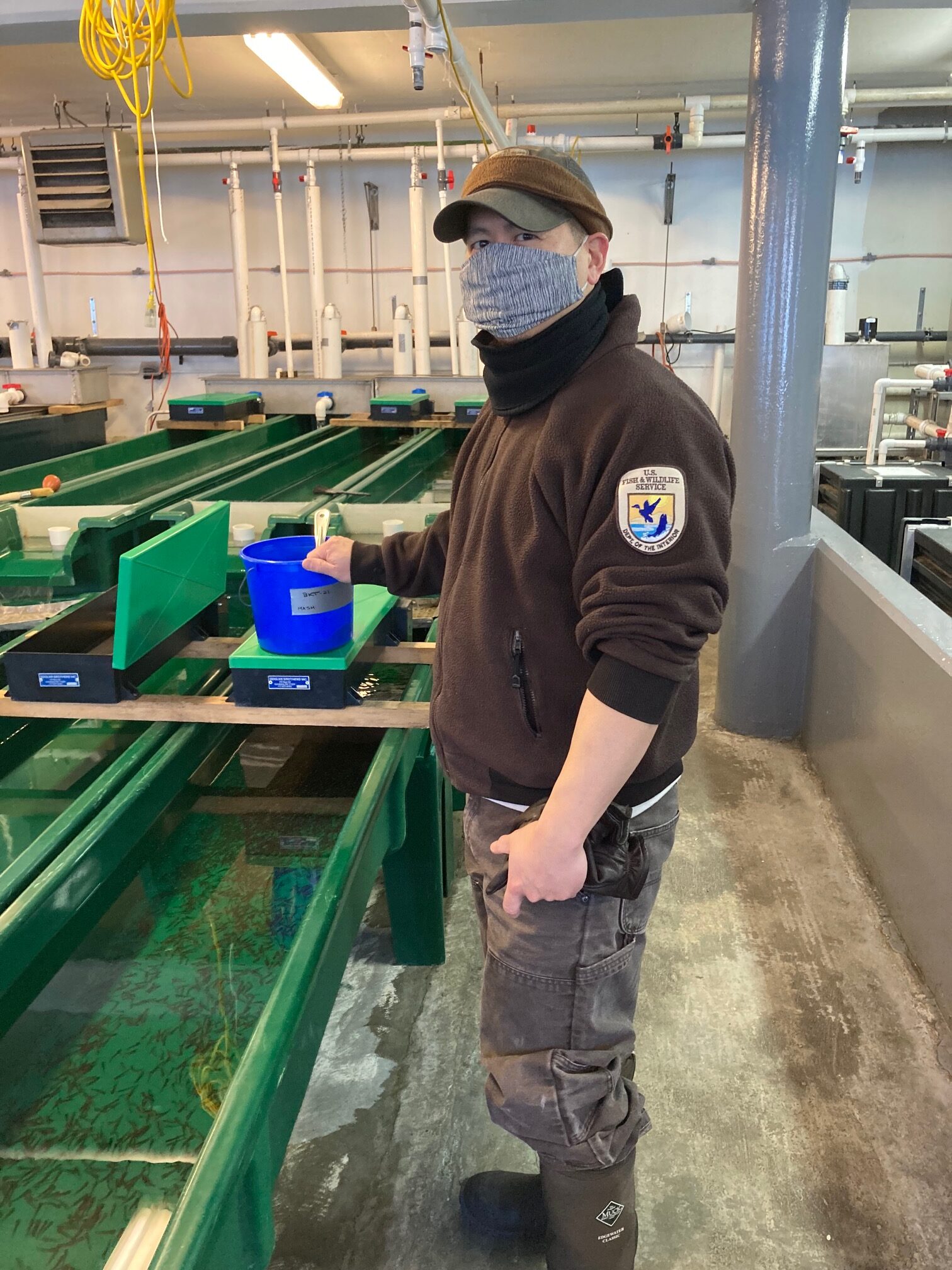 dropped as I gained elevation, climbing the western slope of the Green Mountains. Dan Wong greeted me and was fully prepared for my arrival. He brought out a cooler containing the plastic containers I’d sent him before New Year’s. Each held approximately 100 eggs. He also provided 19 Zip-lock baggies of fish food and two critical numbers: the temperature of the water in which the eggs had been developing–40 degrees–and their DI (Development Index)–50.5. It turned out that Dan was giving me eggs that had been transferred from the Roxbury hatchery just a few days earlier. Since Dan doesn’t have access to very cold water, his eggs had developed too quickly and were no longer eggs.
dropped as I gained elevation, climbing the western slope of the Green Mountains. Dan Wong greeted me and was fully prepared for my arrival. He brought out a cooler containing the plastic containers I’d sent him before New Year’s. Each held approximately 100 eggs. He also provided 19 Zip-lock baggies of fish food and two critical numbers: the temperature of the water in which the eggs had been developing–40 degrees–and their DI (Development Index)–50.5. It turned out that Dan was giving me eggs that had been transferred from the Roxbury hatchery just a few days earlier. Since Dan doesn’t have access to very cold water, his eggs had developed too quickly and were no longer eggs.
Several schools were closed for the day, but those teachers had either arranged to be at the school anyway or offered to meet me and most of the other volunteers in the parking lot of the former Holiday Inn in Rutland.
My first stop was Neshobe Elementary School, about twenty minutes north of the hatchery. Second-year TIC teacher Kim Faber and her enthusiastic students interrupted their work comparing the trout tank habitat with the native stream environment where trout would normally grow.
From there it was all southward: first I met Joe Kraus and give him eggs for Rutland Town School, Rutland’s Northeast Primary School, and Rutland High School. Then on to the Holiday Inn. Sabrina McDonough was waiting there to get her eggs for Shrewsbury Community School. Trip Westcott and Tom Culvert were eager to deliver eggs for elementary schools in Poultney, Proctor, and Tinmouth. Because of a late tank set-up, Jenn Tifft was going to babysit Proctor’s eggs in Tinmouth for a few days.
Gary Saunders picked up eggs for four schools in his area: Currier Memorial School, Dorset School, Manchester Elementary and Middle School, and Maple Street School. Barry Mayer collected the egg containers for our southern-most schools: Fisher in Arlington, Shaftsbury Elementary School, and Mt. Anthony Union MS.
Finally, I delivered eggs to the last four schools: Mount Holly, Ludlow, Fair Haven, and Castleton Village School. By 1:00 pm we were done.
[slideshow_deploy id=’1290′]
Eleven-year-old Master Angler!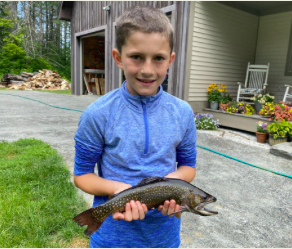
When I visited Ludlow Elementary School today, I had the privilege of meeting Lisa Marks‘s son Owen, who has become an enthusiastic, dedicated, and accomplished fly fisherman. Last summer he caught two trout that many anglers won’t catch in a lifetime: a 15 inch brook trout and a 19.5 inch rainbow, both on flies. Owen proudly showed me the photo his mother took of his massive brookie. Owen has also learned about Vermont’s Master Angler program and during 2021 logged four qualifying entries on that list, all caught on flies.
How’s it going?
As you can probably guess, it’s been a bit of a rocky start to the TIC year. Because of the pandemic and its challenges, some teachers decided relatively late not to participate in the program this year. Even so, it appears that 83 schools are participating in TIC during 2022, and a few schools have two tanks. That’s pretty impressive!
The pandemic had other consequences for our program. As we’ve been used to hearing, “supply-chain disruptions” have greatly interfered with teachers’ abilities to acquire needed equipment, especially chillers. I believe it was the case that no one who needed a new chiller was able to get one. As a result, some of us had to be creative in finding unused chillers in corners of the state and redeploying them at schools, sometimes at great distances, that needed them. Thanks to all volunteers and teachers who assisted with that “musical chillers” process!
One of the challenges of the year was due to the unseasonably warm temperatures we had in December. These made it difficult for our hatchery colleagues to slow the development of our eggs. Towards the end of the raising process, they were worried that our eggs might hatch before we could get them delivered. Because of their special efforts, that was largely not the case. Only one of the eggs I delivered today had hatched by the time I reached the school (Neshobe). On the other hand, the DI, usually 44 at this time of year, was 50.5 today. That means that hatching will occur almost immediately and that it will be difficult to pull off the “cool and slow” temperature protocol.
For reasons that I don’t fully understand, some schools didn’t get setup in time. In some cases that was because of late-developing equipment problems. We also had issues with pre-cycling processes that seemed to stall midway through, resulting in high nitrite levels too close to the time that eggs were expected. This necessitated some hurried eleventh-hour water changes to bring those nitrite levels down.
All considered, however, I think we’re off to a good start,
November 4, 2021
Equipment and supplies, TIC workshops, stream clean-up work, and redd hunting
I’m back, and so are you, and it’s time to get set up for another year of TIC.
The numbers are still moving up and down, but it looks like we may have 95 teachers and 86 schools doing TIC this year. That’s a bit down from our peak of 2019-2020, when we had 99 schools, but way up from last year’s 49.
Equipment and setup.
I know first-hand that some teachers are still trying to secure some of their equipment. In my region of southwestern Vermont, one of our 22 schools still has equipment needs. If you’re a teacher who doesn’t have everything, please ASAP work with your local TIC volunteer or regional coordinator to plug that gap. You can find contact information for your regional coordinator here.
In addition to equipment, you’ll need replacement supplies. These are the solutions and test kits that typically get used up or whose “shelf life” expires each year. See Appendix A of the VTTIC Manual (click link to get manual) to confirm what those are.
And for teachers who took last year off, I will point out that we’re “leaning in” on pre-cycling. In contrast to our recommendation two years ago, we want to strongly encourage teachers to pre-cycle, AND to be successful at that, we urge you to buy, if you don’t have one already, an inexpensive tank heater. (See Appendix A for details.)
Virtual TIC workshops
I trust you all know that we decided to cancel the in-person workshop and switch to “virtual” programming instead. That means that teachers and volunteers will gather at one-hour Zoom meetings at 4:00 pm on three days in November and one day in December. Before the first two of these, participants will be asked to prepare by watching two YouTube videos that were recorded at the November 2019 fall workshop by TU member Ian Sweet.
Here are the details:
Three 4:00 PM sessions preceded by videos that you watch on your own. You’ll find the videos here: https://www.vttucouncil.org/?page_id=755
1) FOR FIRST-TIME TIC TEACHERS AND VOLUNTEERS, watch “Six Months of TIC” (8:34”) and Bob Wible’s tank setup video (45:47”) prior to a Zoom session at 4:00 pm on Thursday, 11/11. LINK: https://us02web.zoom.us/j/86375747488
2) FOR ALL, watch Jeremy Whalen’s presentation (25:54”) and Robb Cramer’s video (32:00”) prior to a Zoom session at 4:00 pm on Monday, 11/15. LINK: https://us02web.zoom.us/j/85345843666
3) FOR ALL, a Zoom session focused on a panel of experienced TIC teachers at 4:00 pm on Tuesday, 11/23. This will allow for Q&A time and give experienced teachers the opportunity to discuss how they used TIC and what they learned while doing it. LINK: https://us02web.zoom.us/j/82077294283
We will also offer an additional Zoom session in December (date and time TBD) on pre-cycling, temperature choices, and swim-up.
Early season stream work
Back when it was a bit warmer, Ludlow Elementary School’s Lisa Marks got her students out into the Black River to do a cleanup. Take a look at her happy and proud kids! Thank you, Lisa and class, for making that river near you look a lot better.
[slideshow_deploy id=’1226′]
Redd hunting
This is the time of year when brook and brown trout spawn. They do so in nests or spawning beds called “redds.” The word redd is said to derive from a Scottish word that means, “to clean an area or make it tidy.” A female trout or salmon will use her caudal (tail) fin to dig a depression in the gravel in which to lay her eggs. Then, once she’s laid her eggs and they’ve been fertilized by the male, the female will sweep additional gravel and stones over the eggs to cover them. Here’s what the redd making process looks like,
Aside from the fact that it’s fun to hunt for redds and altogether awesome to find trout spawning on one, Redd hunting also serves a scientific purpose. Fisheries biologists will use the number of redds and their distribution to assess the health of a trout stream and the quality of its habitat.
Here’s a video that tells you how to identify a redd and where to look for them. It will also teach you how to use a smartphone app to easily log information about the redds you find. Doing so, which many people call “citizen science,” will help Jacob and others understand Vermont’s rivers and their trout better.
Finally, you and your student can search for redds in your neighborhood. Here’s a presentation by Trout Unlimited biologist Jacob Fetterman on how to look for redds.
Mettawee River, October 12, 2021
Let me close with a photo I took on an October fishing outing. Soon there will be snow! Enjoy.
June 13, 2021
To paraphrase Elsa in the movie Frozen, “Let ’em go!” Vermont’s trout are released!!
Friday morning I drove to Neshobe Elementary School in Brandon to join Kim Faber and her 4th graders on their Release Day. Kim and the students walked about a mile from her classroom to a beautiful gorge of the Neshobe River while Kim’s assistant and I netted their 44 fish and put them in a Tupperware container. The Neshobe students were joined by Gary Meffe, a local Trout Unlimited member, who earlier in the spring talked to Kim’s students about fly fishing, insects, what trout need to survive in the wild, and what makes for a healthy stream. Here are a few photos I took that day.
[slideshow_deploy id=’1172′]
Ferrisburgh Central School
Judy Elson sent me these photos of Ferrisburgh Central School 5th and 6th grade students releasing 44 Brook Trout fingerlings into Lewis Creek in Starksboro, Vermont, at the Common Ground Center on June 9, 2021.
[slideshow_deploy id=’1188′]
Another damsel in distress
Danielle Levine, of the Schoolhouse Learning Center, sent me this report and photo.
Today we found a damselfly buzzing around the classroom… Turns out a nymph we caught and were observing in our tank (with no top screen) had hatched from its exoskeleton which was sitting on a log in the aquarium (a second one we keep separate from the trout). So cool!
Charlotte Central School
Chris Evans, of Charlotte Central School, sent me this summary of their Release Day.
What a successful trout release day for our 6th graders at Charlotte Central School! We released 51 brook trout in Lewis Creek at Cota Field in Monkton. We rotated through 4 stations: searching for macroinvertebrates in the creek // fly casting workshop with TU member Mike Hulvey // playing “Trout and Caddisfly” food chain game // field journaling along the banks of the creek.
Chris also sent me this short video of his students learning how to fly cast.
Academy School report
Sarah Kaltenbaugh provided this update:
We split our 150 fish eggs over 2 tanks. We had just 14 survive 🙁Our release day was fantastic! We did a stream observation, a simulation of how many trout die in the wild and from what causes, a search for organisms that might indicate how healthy or not the stream is, and then we released the trout!
So how’d we do?
I’m still waiting for reports from 14 of our schools, but here’s what I know so far about survival rates across the state.
- Survival rates ranged from zero to 55 this year.
- The average number of fish released was 17.5. (Who released half a fish?!)
Here’s a column chart presenting the distribution by deciles.
Considering the challenges of figuring out how to raise Maine’s heritage strain of brook trout, I think those data represent a great collective success! And I’ve heard from many of you, including some who lost just about all your fish, that students got a great deal out of the program. It’s a credit to you as teachers that you can turn challenge and even disaster into a learning opportunity for your kids. Way to go!
May 17, 2021
2020-2021 continues to be an extraordinarily challenging year.
Most of our teachers, even those with many years of TIC experience, worry as never before about their remaining fish. To put our problems in perspective, even the aquariumist (is that a word?) who for many years has been in charge of the Montshire Museum’s impressive freshwater tanks setup is down to one last fish. Of course, that fish is being treated royally and is eating like a king–or maybe a queen. Click on the following link to see MM’s web cam and their designated survivor.
https://www.myearthcam.com/montshiremuseum
Maple Street School
Last week I visited Suzanne Alfano‘s classroom at Maple Street School. Like so many teachers, Suzanne was worried about her fish. Suzanne reported that she had about 30 or 35 fish. About a third of them looked weak and skinny, so she still had them in her breeder basket, but she had released the other two-thirds into the main tank, and they seemed to have grown some. Since I was going to be in the neighborhood for a grandson’s lacrosse game, I offered to make a “house call.”
Here’s a video Suzanne sent me that I found helpful.
When I saw Suzanne’s fish in person on May 11, I was concerned about the way they responded to food–or, more accurately, didn’t respond to food. Most of them–and these were the stronger of Suzzane’s fish–were almost immobile on the edges of the bottom of the tank and showed no interest in the food Suzanne was providing. All her water chemistry numbers seemed near-perfect, so problems in that area did not explain their lethargic behavior. Since Suzanne had a second breeder basket, I suggested that she might try catching the fish loose in the tank and putting those fish in the spare basket.
Today, however, I got this encouraging update:
Wondering if Wednesday is too early to release the trout? At least the big ones. They were overly active in the breeder basket so the kids released them back into the tank. They are swimming all over the place. I don’t see them coming to the top for food but they seem to be thriving. When we were in the outdoor classroom today we saw a fry! The kids were so excited and want to release the others into that spot.
I said, Go for it!
Release Day
Suzanne’s last question prompts me to offer some ideas about release days. These will be familiar to experienced TIC teachers.
- WHEN? In a normal year, we’d advise teachers to plan release day for anytime from the middle of May to the middle of June. This year, because our fish arrived late and, in most cases, developed slowly, we’re favoring the second half of that month-long period. As you choose your date, however, you should also pick a rain date. We’re not just worried about getting wet, which can actually be fun, but the bigger concern is the dangerously high water that can follow heavy rain.
- WHERE? The ideal stream site for a release has several qualities:
- Decent trout habitat, that is, an unpolluted stream that stays cool throughout the summer and has the kind of “structure”–rocks, logs, undercut banks, etc.–that can provide hiding places for little fish.
- A small stream is best. By that I mean three to six feet wide with some depth (at least six to ten inches) but not so much depth that your students could get into trouble should they slip or fall.
- Either on public land or on private land that you’ve been given permission to access.
- A location with adequate, safe parking space for whatever school and volunteer vehicles will be driven to the site. Preferably, students won’t have to cross a busy thoroughfare to get from, presumably, their school bus to the stream.
- A good site will allow relatively easy access to the stream (no precipitous banks to descend).
- The ideal site will also have a flat, open area where the participants can assemble, be given their instructions, perhaps engage in TIC-related activities, and celebrate their achievements at the end of the process (maybe even eat trout-themed cookies or cake!).
- Some teachers pick two sites, one that is their preferred site and a second back-up site higher up in the watershed in case the first site is “blown out” by a heavy rain. (After a heavy rain, higher elevation small “upland” streams return to pre-storm water levels quickly while it can take “lowland” streams in the valley days to recover from a big rain event.)
- WHAT? Most Release Days are multi-faceted events that take about half a school day. Planning such a program requires that you can recruit volunteers to assist you. Here’s a list of the kind of activities that past TIC teachers have incorporated into their RDs:
- Study and evaluate the quality of the “riparian zone” (if you don’t know what that is, look it up; it’s very important).
- Teach students how to analyze the release stream, finding its runs, pools, pockets, and riffles as well as its woody debris, underwater structure/protection, and the trees and shrubs that provide protection from predators and excessive sunlight.
- Test stream water.
- Measure the speed of the stream.
- Estimate the volume of the stream.
- Collect and classify macrovertebrates. (Look for the macros charts within the Insect identification charts folder in the TIC Resources collection. Print these in color on card stock and laminate them.)
- Use the “macros” data your students generated to calculate the stream’s “biotic index,” a measure of its health. (Check the same folder mentioned above to find one or two biotic index worksheets.)
- Make trout art or write trout-themed poems or essays.
- And perhaps the piece de resistance: “electro-fishing.” This, usually conducted by a Fish and Wildlife staff person, involves putting an electrified probe into the water to temporarily stun fish so that you can examine and measure them, etc. It’s always a hugely popular demonstration.
If you have a large class, you may want to plan a series of activities at different stations and then have students in small groups accompanied by an adult cycle through these stations.
Here’s an image of the schedule for a release day at Middlebury’s Mary Hogan School.
Other RD resources.
Our VTTIC web site includes a page of RD videos. Check them out to see release days in action.
You can also see reports of previous years’ RDs in our archived blog posts.
Here‘s a link to blog posts for 2019-2020. Here‘s a link to the blogs for 2016-2017, and here‘s a link to the 2015-2016 blog.
Finally, don’t hesitate to reach out to your regional TIC coordinator or volunteer if you need help planning your RD or recruiting RD helpers.
And finally: cicadas!!
I have the great good fortune of being in Bethesda, Maryland, when Brood X (Brood 10) of the cicadas are in town. As many of you know, cicadas are insects that live under ground for most of their lives–in the case of Brood X, for 17 years–until they crawl out of the ground, shed their last exoskeletons, mate, lay their eggs, and die.
Here’s a picture of a cicada exoskeleton that I took this morning as I was walking my grandkids to school .
It’s quite fascinating to think about this interesting species. Why the 17-year cycle? Isn’t it curious that all the cicadas return in cycles that are prime numbers. Why do they return in such massive numbers? This map shows where they’re expected to appear this year although it’s not anticipated that they’ll arrive farther north than southeastern New York. So I doubt that Vermonters will be able to find any cicadas within their state’s borders. I could be wrong though, especially for those of you who live in Bennington and Windham counties.
They’re also interesting to us TIC folks for other reasons. There are similarities between cicadas and some of the macroinvertebrates our trout will live on. For one, both groups of insects spend the vast majority of their lives in larval form and have a very brief period as winged insects (look the details up of, say, a mayfly and a cicada). A second similarity is that both types of insects spend only a few brief days above ground and the rest of their lives, in the case of cicada, underground and in the case of macroinvertebrates, under water. Finally, both groups repeatedly shed their exoskeletons as they grow.
So, learning about cicadas teaches us something about the macros our trout feed on.
April 18, 2021
Boy, those Maine fish grow at a different rate than the Rome strain!
The data on the relationship between Cumulative Development Index (DI) and swim-up behavior continue to trickle in.
- Kim Faber, Neshobe School, reported that at a DI of 91.6, six of her alevin were swimming up.
- But, on the other hand, South Burlington’s Nathaniel Moore said he first noticed some fish swimming up at a DI of 81, with all swimming up when DI hit 86.
- And Kestrel Plump found the swim-up began at 92; about half were doing it at 97; and that swim-up was completed when the DI hit 105.
So, the numbers are all over the place. Fortunately, next year we should be back to using the Rome strain for which we several years of historical data. You know how much I love your data!
Lots of very active fish
I’ve been getting a lot of reports of active fry. Some teachers have sent me short videos of their fish. Here’s a video Lisa Marks sent me of the fry in her Ludlow Elementary School tank.
Chuck Goller, TU member and TIC volunteer for several northern Vermont schools, sent me this video of the fish in Lisa Young’s class at BFA Fairfax. Enjoy!
Lisa, who pre-cycled her tank, also provided this report:
The chemistry has stayed perfect! Nitrites and ammonia are staying at zero. Nitrates are going between 20 and 40 but mostly around 20. I haven’t had to do a thing!
And, of course, every so often I have to check to see how the fish at the Montshire Museum are doing. The image below is a screen shot, but click on it to go to the museum’s web cam. It’s not always live, but usually it is.
April is National Poetry Month
How about some trout-themed poems!
Ludlow Elementary’s Lisa Marks told me that she’s been having her students write “one last word” poems inspired by the line “step into the cold river” from this poem by Kristine O’Connell George.
Cool idea Lisa! I’d love it if you can share some of those poems with me/us.
Several years ago Jason Gragen, then teaching at Jamaica Village School, now at NewBrook, had his students illustrate the Cormac McCarthy poem “Once There Were Brook Trout.” They did an amazing job! And how about using that poem to stretch your students’ vocabulary? Wimpled? Torsional? Vermiculate?
Here’s McCarthy’s poem.
Here are the illustrations that Jason’s students drew based on McCarthy’s poem.
[slideshow_deploy id=’1127′]
March 29, 2021
Mysterious deaths at Schoolhouse Learning Center
On March 23, Danielle Levine, of Schoolhouse Learning Center, sent me this message.
We have had 3 fish die from what looks like their yolk sac bursting. Any ideas? I am attaching photos. We cleaned the tank yesterday but have had normal levels all along.
Danielle said it looked like the egg sac had exploded. She included three photos. Here’s one of them.
I shared these images with my favorite consultants, and Tom Jones, fisheries biologist at the Vermont Department of Fish & Wildlife came back with this response.
I work as a fish pathologist with VT F&W. I’ve looked at the pics provided, and it is often difficult to pin-point the exact cause. I first want to inform that this condition is not uncommon and we occasionally see it to various degrees in trout and salmon culture. Many things have been reported to cause this type of condition to include but not limited to: bacterial infection, fungal infection, physical injury to the yolk-sac (possible abrasion to the exterior of sac, often leading to opportunistic bacteria and fungi), poor water quality factors during incubation and early sac-fry environment. There is no treatment once seen other then providing optimal water quality conditions and rearing environment for the fry.
The good news is that Danielle‘s tank had no additional casualties over the next few days. I guess the crisis has passed.
Active alevin
Lisa Marks, of Ludlow Elementary School, sent me this great video of her fish. Some of them are pretty speedy.
“Virtual” TIC tanks
As I think you know, two great Vermont museums are hosting TIC tanks this year. Both the ECHO Leahy Center and the Montshire Museum installed tanks very similar to those all our Vermont schools use. They also received brook trout eggs as part of the same state-wide delivery system we use every year.
Here’s a link to the VTTIC web site page where you can find links to the museum video feeds and also to their most recent tank data. Check it out!
Zoom consultation meeting
Last Thursday evening, 18 of us met on Zoom to hear reports on how our VTTIC programs were going, to answer questions from teachers and volunteers, and to hear some advice on the next stages ahead of us, especially swim-up. It seemed like a productive and efficient way to check in and benefit from shared expertise. We’ll do it again in a few weeks.
March 21, 2021
When did our eggs hatch?
I haven’t yet hear from most schools, but here are a few early reports on what the DI was when (a) the first eggs hatched and (b) all or almost all of the eggs had hatched. Where do yours fit in?
Spring has sprung!
This is, from my point of view, the most exciting time of year, at least if you live in a place like Vermont and are interested in nature. Almost every day, there’s some new sign of the emerging season to note. It’s the perfect time to introduce your students to PHENOLOGY. (If you need to, look up that somewhat unusual word.)
I learned about phenology last spring from Guy Merolle, previously the TIC teacher at Castleton Village School who now teaches at Fair Haven Union High School. Every week last spring, even after his school was shut down by the pandemic, Guy sent his students a “phenology report” and challenged them to document and send him evidence of the changes they had observed taking place in nature. He even included cooking–and eating–demonstrations. It was a rather cool way to get students to attend to the world around them.
Here’s the phenology report Guy sent his students last March 23, 2020.
If you like Guy’s approach, I put together a page of the ten reports he produced throughout the spring. Here’s a link to that page, which you can find on the VTTIC web site too. You’ll also get to see Guy’s adorable sons.
Catkins!
Here’s one of the early signs of spring I spotted yesterday in Manchester: catkins exploding on an old aspen tree.
Alevin
Speaking of unusual words, what about “alevin”? First of all, how do you pronounce it? Well, you say AL-a-vin. And what are they. Alevin is the stage between eggs and fry. So as soon as your eggs are hatched, we call them alevin. And that’s what they are until–ta da!–they start feeding, when they become fry.
Here’s a photo of the alevin at Harwood Union Middle School, which Angela Selvaggio sent TIC volunteer Clark Amadon.
They look good. Angela also said,
They’re doing great so far! I’ve pulled out one egg that appeared to have fungus. Picture attached! The students LOVE them….check every day to see how they grow and change.
March 14, 2021
Much hatching going on
I’ve gotten several reports on egg hatching across the state. (I need much more information from you, including answers to such questions as What was the DI when your eggs first hatched? and What was the DI when they were all hatched?)
Here are some of the early reports:
- Suzanne Alfano, at Maple Street School, said that all her eggs were hatched when the DI hit 59.
- At the Montshire Museum, Lorenz Rutz reported that hatching began at a DI of 50 and was mostly completed when the DI hit 56.
- Chuck Goller, one of the TIC TU volunteers for northern Vermont schools, told me that their first hatches occurred when the DI was just 48.71.
What was the DI when your eggs started hatching? What was it when they were all hatched?
Fungus and foam. Oh no!
Jenna Abatiell, of West Rutland School, wrote to say that small patches of white fungus had begun to appear on the netting of her breeder basket. Here are two photos of that worrisome growth.
What to do? I contacted our most scientifically knowledgeable TIC volunteer Dartmouth professor Robb Cramer. Here’s what he recommended:
Definitely replace the net. Visually inspect each egg to see if there is fungus on it and discard eggs with fungus.
I’d be tempted to ask Jeremy about another anti-fungal treatment of the eggs. I don’t want to suggest something w/o being award of the DI of the eggs and their susceptibility to an anti fungal. The fungus almost certainly came from the eggs.
I have since Asked Jeremy Whalen if he can recommend an anti-fungal treatment. Jenna very quickly replaced the breeder basket. Let’s all keep our fingers crossed fo her tank.
Here, by the way, is the Wikipedia article on saprolegnia: https://en.wikipedia.org/wiki/Saprolegnia.
Now, what about foam?
Lisa Marks, of Ludlow Elementary School, shared this report.
There’s a crazy foam in the tank this morning. Can I text you a picture. The eggs have hatched and so far look great.
Here’s the picture she sent:
As I usually do when I get a question I can’t answer, I turn to someone with more knowledge and experience than I have. In this case, that meant Dr. Robb Cramer (again) and Tare Granke, TU’s national TIC coordinator.
Tara responded with this:
It looks soapy. Is it soap? Without more info all I can say is scoop it off the top if it doesn’t seem to be harming the fish or water chemistry. Could be protein bubbles. Maybe there is a dead fish in the filter.
Lisa assured me that she’s fastidious about keeping soap and other harmful products out of the tank; and, if it were caused by soap, the bubbles would probably have a rainbow sheen on them. Since her fish are just barely out of the shell, it’s highly unlikely that there’s a decomposing fish in the filter or anywhere else. Lisa removed the foam, and the next day it was back.
Robb Cramer’s response focused on the protein. Here’s what he said:
It is from too much protein in the tank. It happens. Clean the filter and do a 25% water change.
And then, Caitlin Kurnit, of Albert D. Lawton Middle School, sent me this photo.
The foam is almost certainly a function of too much protein that is the result of decomposing egg shells! Make sure you suck those discarded egg shells out of your tank.
Spring is on the way.
The weather lately has been on a rollercoaster ride! On Friday the temperature pushed 60. As I write this Sunday afternoon, it is 27 degrees with blustery winds. Nonetheless, most of the snow has melted, and the rivers are clearing up and the levels dropping. Here’s what the Castleton River near my home looked like on Friday. For those of you who have kids who fish, Vermont’s trout season begins in less than a month.
Finally, make sure you maintain the data reports. In a little bit, we’ll be talking about “swim-up,” that critically important time when your temperature and DI records will help you determine when your alevin are ready to start swimming up for food. Without good data, it will just be a guessing game.
February 28, 2021
Eggs are getting out!
Starting last week, Dan “Rudi” Ruddell and his eastern Vermont colleagues delivered eggs to schools in the Greater Upper Valley area. Rudi visited Erik Anderson, at Chelsea Public School; Chris Franske, at Tunbridge Central School; and Monique Perry, at Williamstown Elementary School. Everything went well. Here are a few photos of Rudi’s recipients.
[slideshow_deploy id=’996′]
Then, this past Tuesday, three of us delivered eggs to nine schools in southwest Vermont. I began the day by picking up eggs from Henry Bouchard, manager of the Eisenhower federal fish hatchery in Pittsford, Vermont. Henry told me that the eggs that morning had been sitting in 47 degree F. water and that their cumulative DI was 43.64. After thanking Henry and saying goodbye, I headed north to deliver to Kim Faber and her 4th grade students at Neshobe School in Brandon. That was a joyful experience! Kim’s students flooded out to meet me at a distance of about 12 feet. They were full of questions and very well prepared. I could easily have spent an hour in our spontaneous Q&A, but eight other schools were awaiting their eggs, so I asked be invited back and headed south. Here are some happy Neshobe kids.
Next, I met TU volunteer Joe Kraus at a veterinary clinic north of Rutland and gave him the eggs, food, and DI information for Rutland Town School and West Rutland School. That allowed me to drive straight down Route 7 to the parking lot of the Holiday Inn, where I met volunteer Gary Saunders, who would deliver eggs for Tinmouth Elementary, Shrewsbury Mountain School, and finally Maple Street School in Manchester.
Finally, I went off with my three last sets of eggs for Lisa Marks (Ludlow Elementary), Will Difrancesco (Castleton Village School), and Kaitlin Grote (Poultney High School). Here are some photos of my part of the egg delivery run.
[slideshow_deploy id=’1002′]
Egg counting!
Maple Street School teacher Suzanne Alfano sent me the photo below of one of her students conducting a count of the eggs received. Suzanne photographed the eggs lying in a single layer on the bottom of the plastic container they had traveled in and then projected that image onto the classroom’s whiteboard. The answer: 109!
Water Protector book
I’m always on the look-out for books and other materials that might pair well with the TIC program. Recently I learned about “We Are Water Protectors,” It’s a beautifully illustrated book that seems appropriate for the youngest students, perhaps pre-K through 3rd grade. Here’s a link to the Amazon page for the book.
It won the 2021 Caldecott Medal. Here’s a blurb describing it:
Inspired by the many Indigenous-led movements across North America, We Are Water Protectors issues an urgent rallying cry to safeguard the Earth’s water from harm and corruption—a bold and lyrical picture book written by Carole Lindstrom and vibrantly illustrated by Michaela Goade.
I think it may make a good companion book to Trout Are Made of Trees, whose upper range may extend to 5th grade.
Data! Part 1
All of you who have participated in the TIC program in past years know that I’m something of a fanatic about the importance of collecting and sharing data on our tanks and their trout. Why do we need data?
- Keeping track of temperature data will allow you to predict or control when your alevin will “swim up,” that is, be ready to feed. If you miss that critical, brief stage, your fish won’t make it.
- Very little research has been done–almost none–on raising trout in tanks.
- If all Vermont’s TIC teachers collected and shared their data, it would serve as a valuable ongoing research project. Every year we’d learn more and more about best practices and what makes for a successful program.
Swim-up
Let’s start with the use of data in managing the swim-up process/challenge. Temperature plays a critical role in trout development. The following table shows how each day, for each tenth of a degree of temperature, a different constant is added to whatever was the previous day’s Cumulative Development Index (DI).
So, looking at the table above, if your water temperature is 40.2 degrees F, the constant of 0.541 should be added to whatever the previous DI was. To make the process of adding those constants easy for teachers, we’ve created spreadsheets, both in Excel and Google Sheets formats, with built-in formulas. To use these, you just need to enter the temperature every day (you estimate what it was on weekend days and for any day you’re not at the school).
This folder in the Google Docs collection contains three files labelled “Temp and DI record and swim-up calculator.” One is a Google Sheets file format; one is an Excel format; and one allows students to enter temperature in Celsius. You should use one of these to track DI.
Worksheet B of this workbook looks like this:
If you enter the date the eggs arrived and the DI on that date, then you just need to enter daily temperature. When the Cumulative DI reaches 85, you should start looking very diligently for evidence of “swim-up” behavior. Review appendices G and H to learn more about swim-up.
Data! Part 2
While it’s important that right now you enter daily temperature into the Temp and DI record and swim-up calculator, once your fry are all swimming up and feeding, you can abandon that spreadsheet. (After you send it to me!) But from the beginning of the TIC project to the very end, you should keep up this spreadsheet.
Whenever you have a problem and need help, e.g., your fish are dying or look poorly, any of the volunteers or outside experts who would try to identify what’s causing those issues will immediately ask for information on your tank water data. And as I mentioned, there’s so little research on raising trout in tanks that we’ve got to build a collection of data to understand what works for our fish and what conditions endanger them.
You can find both of these spreadsheets and much more in the Google Docs Collection.
There’s a link to that collection in the TIC Resources pop-up menu on our web site, which is a subset of the Trout Unlimited State Council web site. Here’s the URL for the State Council site: https://www.vttucouncil.org.
.
Virtual TIC tanks. Montshire Museum tank cam online!
One of the items available in the VTTIC web site pop-up menu is a link to the two museum partners who, for the first time this year, are hosting tanks with brook trout eggs. They are also posting their water quality data. Check it out! Either go to the pop-up menu or click the image below.
February 9, 2021
Quilt project
I got the following e-mail from Tara Granke about the annual TIC/SIC quilt project.
The Salmon & Trout Quilt Square Project lives on! This year we return to the traditional model of mailing fabric squares and a letter to participating classrooms.The Trout and Salmon Quilt Square Project is a hands-on STEAM activity through which students reflect on their STEM-learning in S/TIC or Adopt-a-Trout by creating a fabric quilt square and writing a letter to another classroom in a different part of the United States. It is a reflection and sharing of their science learning around a theme as well as a geographical and cultural exchange through writing and mailing letters. The interdisciplinary learning is endless and can include lessons in: language arts, history, geography, ecology, chemistry, recreation, fine arts, folk arts, biology and more!Sign ups are open now through February 16. Teachers can sign up here: https://forms.gle/uoBE1mKYV1rFn1SX7After signing up, teachers will receive a confirmation email and instructions from me, TU Headwaters Coordinator, Tara Granke. I have attached the instructions (click on the image below to access the instructions) but TEACHERS MUST SIGN UP USING THE GOOGLE FORM TO BE INCLUDED IN THE MAILING LIST. If you do not sign up, other classrooms will not know how to send the squares to you.Ideas for classrooms that are learning virtually are included. For more information about this hands-on, STEAM project, please see the attached instructions.
Here’s a slideshow of photos from past quilt projects.
[slideshow_deploy id=’988′]
Don’t forget, the deadline is a week from today!
January 14, 2021
While I wait for news about when our brook trout eggs will be transported from Maine to the Roxbury and Eisenhower hatcheries, I’m finding lots of interesting ideas that you or your students could pursue in the meantime.
Trout journals
Do your students need to practice their writing? Well, how about getting them to keep a trout journal? The image below will link you to a page in the national TIC resource collection that describes how your students might create a trout journal and what they might write about. There are more than 20 prompts for student writing. Check it out!
Idaho TIC Activity Guide
The image of the cover below will take you to the activity guide of the Idaho TIC program. One of the first activities you’ll find there is, on page 4, another description of how you might approach a student trout journal.
Fish art!
How about getting your students to produce fish art? If they want, they can enter their work in a contest (for grades 4th through 12th). The deadline is March 31, 2021. Click on the image below to learn more about the contest and how to enter. You’ll also find several special contests like one for artwork and essays associated with our state fish, the brook trout. The Wildlife Forever web site contains links to some great curriculum materials. And finally, there’s even an opportunity to nominate some worthy colleague as Educator of the Year. Consider it!
Here, by the way, is last year’s Vermont winner, 3rd grader Jackson Fellows. Congratulations, Jackson!
ThatFishPlace equipment set-up videos
ThatFishPlace, which is a TIC corporate partner, has developed three YouTube videos on how to set up TIC equipment. As I understand it, more videos are in preparation.
Here’s one on setting up the air pump/bubbler.
This video explains how to use the siphon to clean the gravel.
And here’s one on setting up the Fluval 406 canister filter, which some schools use.
Thank you, ThatFishPlace! We look forward to your other videos.
And while we’re at it, don’t forget the videos we already have on the Vermont TIC web site. Click on the image below to go directly to that page, which can be found in the TIC Resources folder.
Virtual Salmon in the Classroom program
The Michigan Department of Natural Resources has established a “Virtual Salmon in the Classroom” program for those teachers who are not running their own tanks this year. It consists of a web site that consolidates numerous YouTube videos that together document the development of the Michigan salmon. Click this image below to visit the site and watch the videos.
December 6, 2020
Pre-cycling should be underway. News on the Roxbury hatchery. Virtual dissection. Braintree Elementary School redd hunt. Salmon sleuths.
PRE-CYCLING 2020
If you’re going to pre-cycle, you probably started the process last week. You can probably begin this week if you want, but it will be especially important to keep your tank warm. We recommend 75 degrees. In my last blog, I advised that you acquire one or more aquarium heaters. It’s important to purchase one that can raise your water temperature sufficiently. Here’s an article on choosing the right aquarium heater. Make sure you read the latest pre-cycling instructions. The earlier version and the one found in last year’s Manual contain an error. Here are the new instructions:
Manual Chapter 4 replacement 11-21-20
Let me know how it goes.
ROXBURY HATCHERY
Most of you know several things about the Roxbury hatchery, technically the Roxbury Fish Culture Station:
- It is the oldest fish hatchery in Vermont and one of the oldest in the country, having opened in 1891
- It was virtually destroyed by tropical storm Irene in August 2011
- Except for while it was being rebuilt recently, it has been the source of the brook trout eggs we use in our program.
Well, the reconstruction of the Roxbury hatchery is now completed and it will again be providing eggs to most of our schools. (Schools in southwest Vermont will be picking up their eggs at the federal Eisenhower hatchery in Pittsford.)
The Roxbury hatchery was recently in the news. Here’s a link to the WCAX TV story about the rebuilt hatchery:
WCAX story about Roxbury hatchery
If you haven’t already met him, the piece will introduce you to hatchery manager Jeremy Whalen, a Vermont Department of Fish and Wildlife employee who is a key part of our TIC support system.
If you need another reason to visit the Roxbury hatchery, consider this: it has the most beautiful brook trout sculpture I’ve ever seen.
It was made by Barre sculptor Sean Hunter Williams and was installed as part of Vermont’s Art in State Buildings program. The trout is a female, by the way. Here’s a link to the Rutland Herald article about the sculpture.
Fish dissection
Learning about trout anatomy by dissecting a fish is one of those educational activities that can be conducted any month of the year, but you have to have access to fish. I think ice fishing season might be one of the best times to beg friends and neighbors for fish they don’t need. That’s when some come home with buckets of perch, sunfish, and smelt. But what do you do when you don’t have fish, or worse, you don’t have students in your classroom because you’re teaching “virtually.” Well, you still have options. Here’s a YouTube video that’s pretty good.
And there are a couple more on the Other Trout Videos page link here.
Braintree redd hunt
For the second year, Janni Jacobs took her Braintree Elementary School students to the nearby Third Branch of the White River to look for redds. As last year, they weren’t able to find any. Dan “Rudi” Ruddell, of the White River Partnership, believes that brook trout redds, being small, are a lot harder to find than brown and rainbow trout redds, which, depending on the size of the fish, can be quite large. In transmitting the six photos below, Rudi said, even though they didn’t find any redds,
We found tons of caddis, mayflies, and stoneflies. Hard to go wrong with a day in the stream.
Braintree [slideshow_deploy id=’919′]
Salmon sleuths
Those of you teaching older students might want to have them read the recent New York Times report on Washington state scientists committed to investigating salmon deaths. It’s a fascinating story. Click on the image to access the piece.
November 11, 2020
Important news on pre-cycling: make sure you’re tank’s warm enough and the Manual had a mistake
Heading into our second Zoom virtual training meeting, TIC volunteer Chuck Goller raised a question about a section of our pre-cycling instructions. Specifically, page 20 of earlier versions of this year’s Manual contain several errors. We have corrected those in the 11/3/20 edition of the Manual now available in the Google Docs folder. I’ve also provided a corrected version of Chapter 4 (on pre-cycling). Here it is.
Manual Chapter 4 replacement 11-3-20
At that same meeting, Robb Cramer stressed the importance of keeping the tank water warm enough during the pre-cycling period–from his point of view that would be 75 degrees. We now suspect that this is a key reason why pre-cycling took much longer than it should have at some schools, where especially overnight temperatures can drop well down into the 60s.
So, we’re recommending that you consider getting a tank heater. You can purchase these for under $30 on Amazon and from other aquarium supply retailers. Here’s one example. (PS: Make sure the capacity of the heater is suitable for the size of your tank.)
First-ever redd presentations, and they’re broadcast live!
On Tuesday, November 3rd, and Thursday, November 5th, fisheries biologists and Trout Unlimited volunteers broadcast live discussions from two Vermont rivers, the Batten Kill and the Dog River.
In Manchester, Jacob Fetterman, project coordinator for the Home Rivers Initiative, talked about reads, how and where trout make them, and how they can be affected by weather and water conditions.
A big thanks to Maple Street School TIC teacher Suzanne Alfano and SWVTTU member Jim Mirenda for contributing to this video.
Here’s the second redd video. It was recorded on the Dog River near Northfield, Vermont by Ian Sweet. The presentation features Fish and Wildlife biologist Bret Ladago and Mad Dog TU member Clark Amadon.
Tiny water spawning
Here’s a short video of brook trout engaged in spawning activities on a super tiny stream in southern Vermont.
Bull Run Dam removal
A diverse coalition of environmentally oriented organizations and agencies collaborated to improve the opportunities for trout and other species to migrate up and down Bull Run Brook in Northfield. A dam built in 1920 to create a swimming pond for a girl’s summer camp denied fish access to 26 miles of trout habitat. Those groups (each has its URL attached)–Friends of the Winooski River, The Nature Conservancy, Vermont Department of Fish and Wildlife, Vermont Natural Resources Council, and Vermont Department of Environmental Conservation–not only tackled the multi-year project of getting the dam removed but also produced this documentary to tell the story.
Training videos recorded
We couldn’t have our normal in-person TIC workshop this year so we went virtual. That included some assigned “homework” in the form of video watching and Manual reading. After each set of homework assignments, we met on Zoom to discuss the topics, share additional information, and answer questions. I’ve assembled video recordings of those Zoom meetings here.
October 9, 2020
Let’s get started!
The past seven months have been the craziest time for Trout in the Classroom as well as everything else! In this first blog post of the season, I’ll comment on the following:
- the prospects for the 2020-2021 TIC year
- a Mayfly Sensor Station installation
- the upcoming redd survey
- a peek at the “enhancements” we’re adding to the program this year
- a youth writing contest
- some holdover fry from last year
Prospects for 2020-2021
As I think you all know, the regional TIC coordinators and I have been trying to get a handle on teachers’ plans for the upcoming year. So far, 88 of the schools that participated in TIC last year have gotten back to us. Of those, 46 plan to do the program; 23 definitely won’t; and the rest are somewhere in between definitely yes and definitely no. Thanks to all of you who have told us of your plans. Here’s a list of schools and teachers who have responded. Let me know if you see any errors or omissions.
Vermont’s first Mayfly Sensor Station!
This past Friday, Jacob Fetterman, several volunteers, and I joined Maple Street School teachers Suzanne Alfano and Julie Mackey and their 5th and 8th graders to witness the installation of the first Mayfly Sensor Station in Vermont. Here’s a link to an article describing the station. The one installed at Maple Street measures water and air temperature, water depth, and electrical conductivity, among other metrics, and can be monitored from any internet-connected place in the world. Here’s a screenshot of the Mayfly sensor read-out. Click the image below to see current data.
Jacob is a scientist on the Trout Unlimited national staff whom three Trout Unlimited chapters, one in southwest Vermont (my chapter) and two in eastern New York, have hired to lead a multi-year project to study and improve habitat on the Batten Kill.
Maple Street School enjoys the good fortune of having the fabled Batten Kill as the eastern border of its campus and an attractive “Kill” tributary, Munson Brook, as its southern boundary. Here are some photos of the event Friday when the Mayfly station was installed.
[slideshow_deploy id=’803′]
Here’s a great video that was posted on GNAT, the public-access TV station in the Manchester area.
Redd survey
Remember redds? I wrote about them last fall, and one of our schools, Braintree Elementary, went out to look for them. There are several YouTube videos of trout building Redds in nature on the Other trout videos page of our VTTIC web site, but here’s one of trout trying to build a redd it in an aquarium.
To remind you, brook and brown trout build redds in the middle-to-late fall when water temperature drops below 52 degrees and there has been an increase in precipitation (rainbow trout spawn in the early spring). This year for the first time, a large group of volunteers, including perhaps as many as two dozen students from Burr and Burton Academy, will be conducting a redd survey on the Batten Kill. Jacob Fetterman has organized that effort, which will take place between October 17 and November 20, and conducted Zoom training sessions on how and where to find reads as well as the use of a special smartphone app for recording the location of the redd and other information. Conducting redd surveys on an annual basis will allow Jacob and others to see whether stream improvement efforts are resulting in trout spawning in new areas of a watershed.
If you’re interested in learning more about reads and possibly going out to look for them, here’s Jacob‘s training video.
A WARNING: Never step on or walk through a redd!
One of the planned “enhancements”
Given that some teachers otherwise enthusiastic about TIC are reluctant to run a tank this year either because of their school’s rigorous sanitizing procedures or because they’re afraid they might have to leave school abruptly, I have asked the ECHO Leahy Center in Burlington if they’d be willing to set up and share a TIC tank with us. They are!
So what will that mean? The ECHO staff will set up a tank on the same schedule that Vermont’s TIC schools would. They will rig it with a web-camera so that TIC teachers and students around the state can watch the tank and its developing eggs/alevin/fry. They will also post their water chemistry and fish data on the internet, making them accessible to teachers. Periodically one or more of their staff will offer a live Zoom Q&A session for schools.
I’ll keep you posted! Many more enhancements are to come.
Writing contest
I recently got an e-mail from Tara Granke, national TIC coordinator for Trout Unlimited, announcing a youth writing contest. Here’s what Tara said:
Any young person aged 12-18 can enter the TU Teen Essay contest for a chance to win a Temple Fork Outfitters rod and reel plus many more prizes. This year’s prompt: Describe the moment you felt a responsibility to become involved with conservation.There are two categories for judging: 8th to 10th graders +11th and 12th graders. Deadline is October 31. See more rules and how to enter at www.tu.org/teen-essaysPlease share with any eligible students or young people in your lives. There is also a Facebook post at www.facebook.com/ticsic

